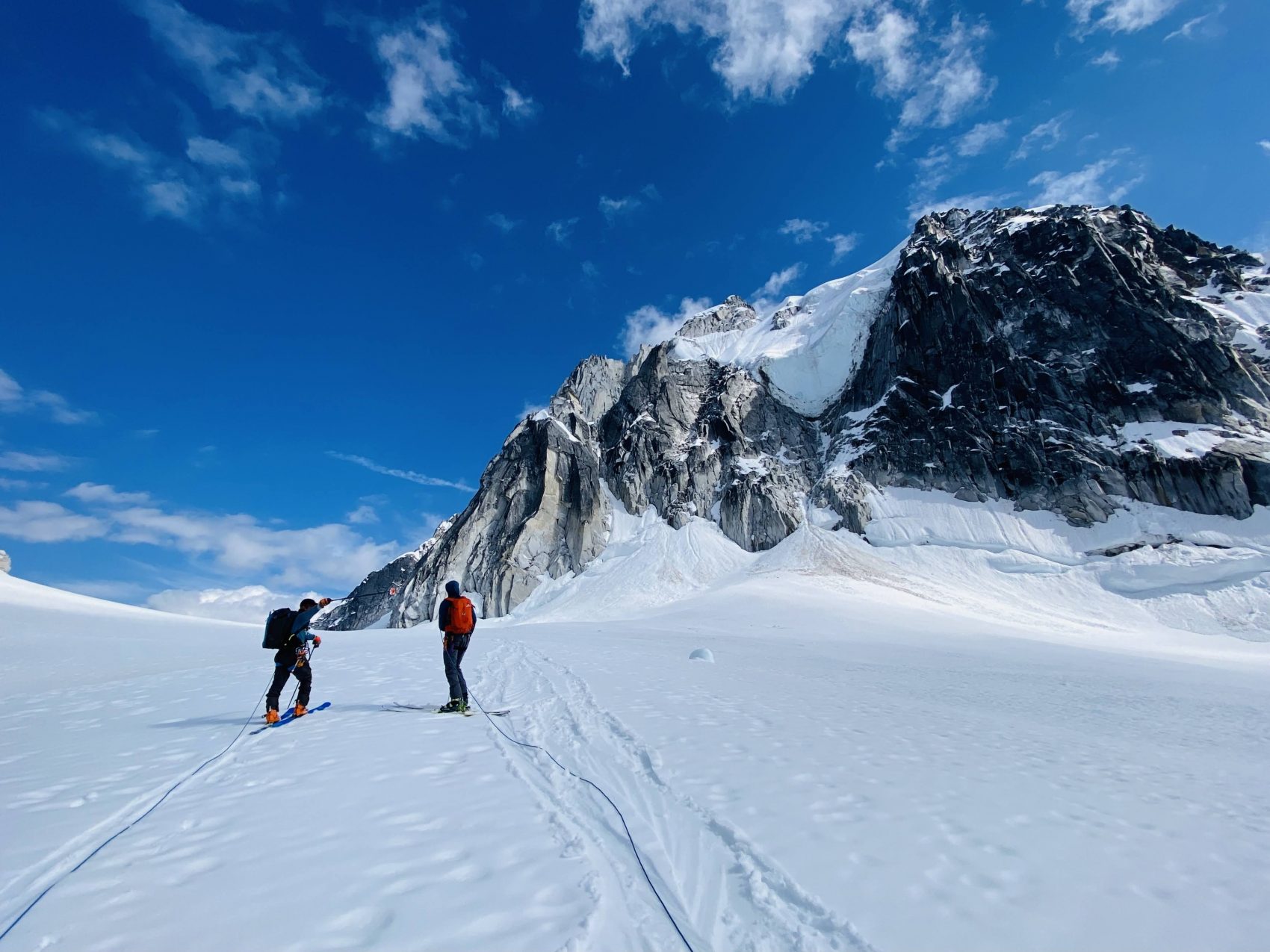
I woke up on July 17 just as I had the previous 30 days; I crawled out of my sleeping bag, packed up my gear, tent, and food into my pack, and began walking. It was my final day of a 30-day expedition bagging peaks on the Nelchina Glacier in the Chugach Mountains, and I was headed straight into my next adventure: ski mountaineering in Denali National Park.
I met my dad that evening in Palmer, Alaska, about 90 minutes East of Anchorage. My dad had not been on the expedition and had hauled all of our ski gear from home in San Francisco. We spent a night in a hotel in Palmer (where I cherished my first shower in a month!) before waking up at about 6 am the next morning to drive to Talkeetna, the typical launch pad for expeditions headed into Denali NP.
Upon arriving in Talkeetna, we staged all the gear we would need: ski equipment, tents, food, fuel, etc. Once everything was sorted into duffels and loaded into the van, we made the short drive across the town to Talkeetna Airport. The airport was buzzing with energy; scenic tour groups, Denali summit expeditions, and other miscellaneous parties milled about the almost city-esc tarmac. The near-constant buzzing of turboprop engines gave us headaches within minutes!
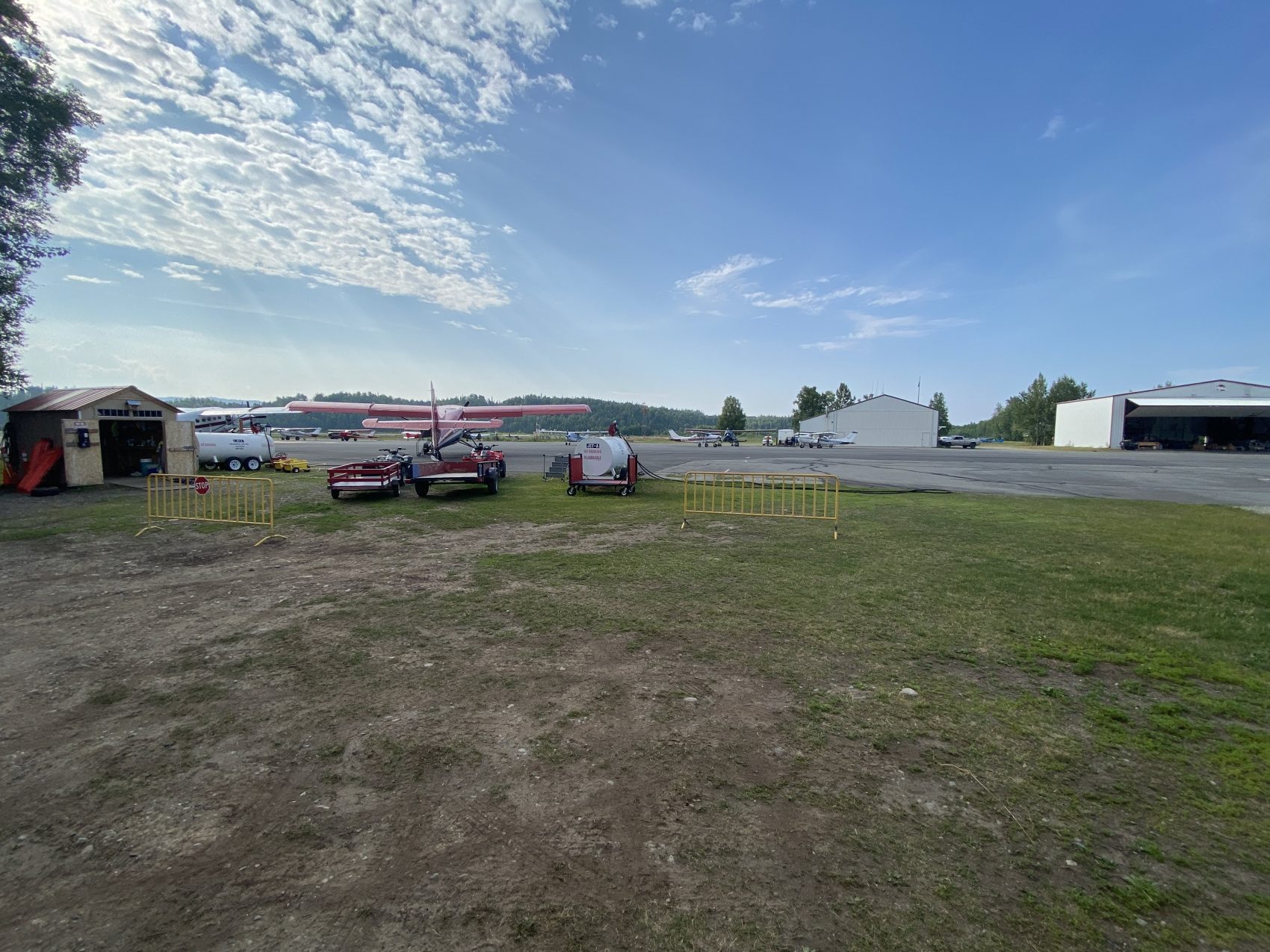
Now, skiing in July isn’t too common, even in Alaska. We got plenty of puzzled looks from scenic tour guests and climbing expeditions alike as we unloaded skis, boots, and poles from the van.
Once we got the go-ahead on the weather (scouted by pilots a few minutes earlier), we hauled all of our gear to the plane, all 1,071 pounds, to be exact. We were bringing plenty of extra food and fuel in case the weather closed up and we were stranded on the glacier for days or even weeks past our scheduled pickup. The struggles that come with planning in the Alaska range!
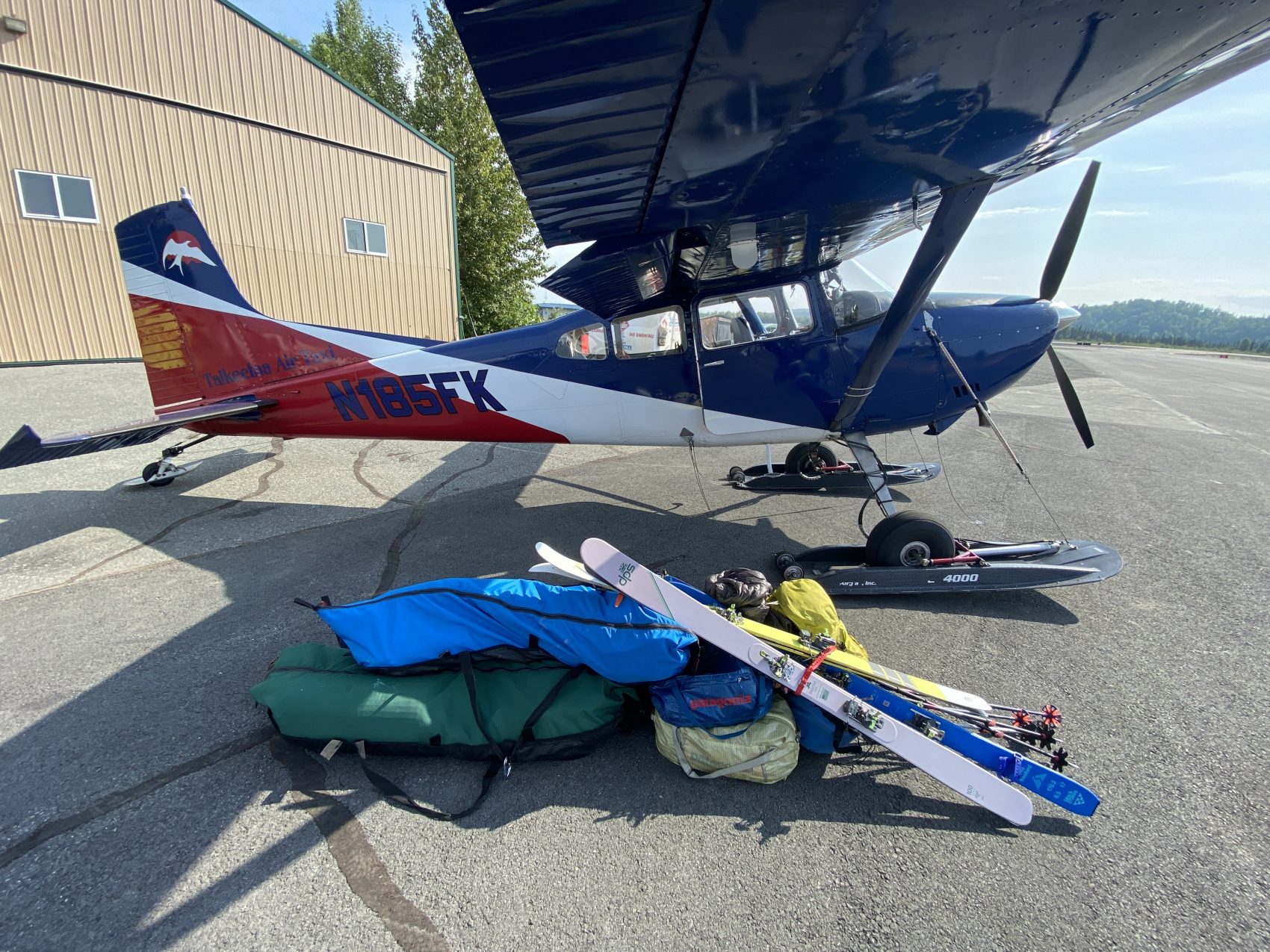
Once we got our skis and equipment nestled in the plane, we loaded up, taxied to the end of the runway, and took off. The flight towards Denali was stunning; sprawling plains mixed with rolling, green hills gradually sloped towards the jagged granite peaks up ahead.
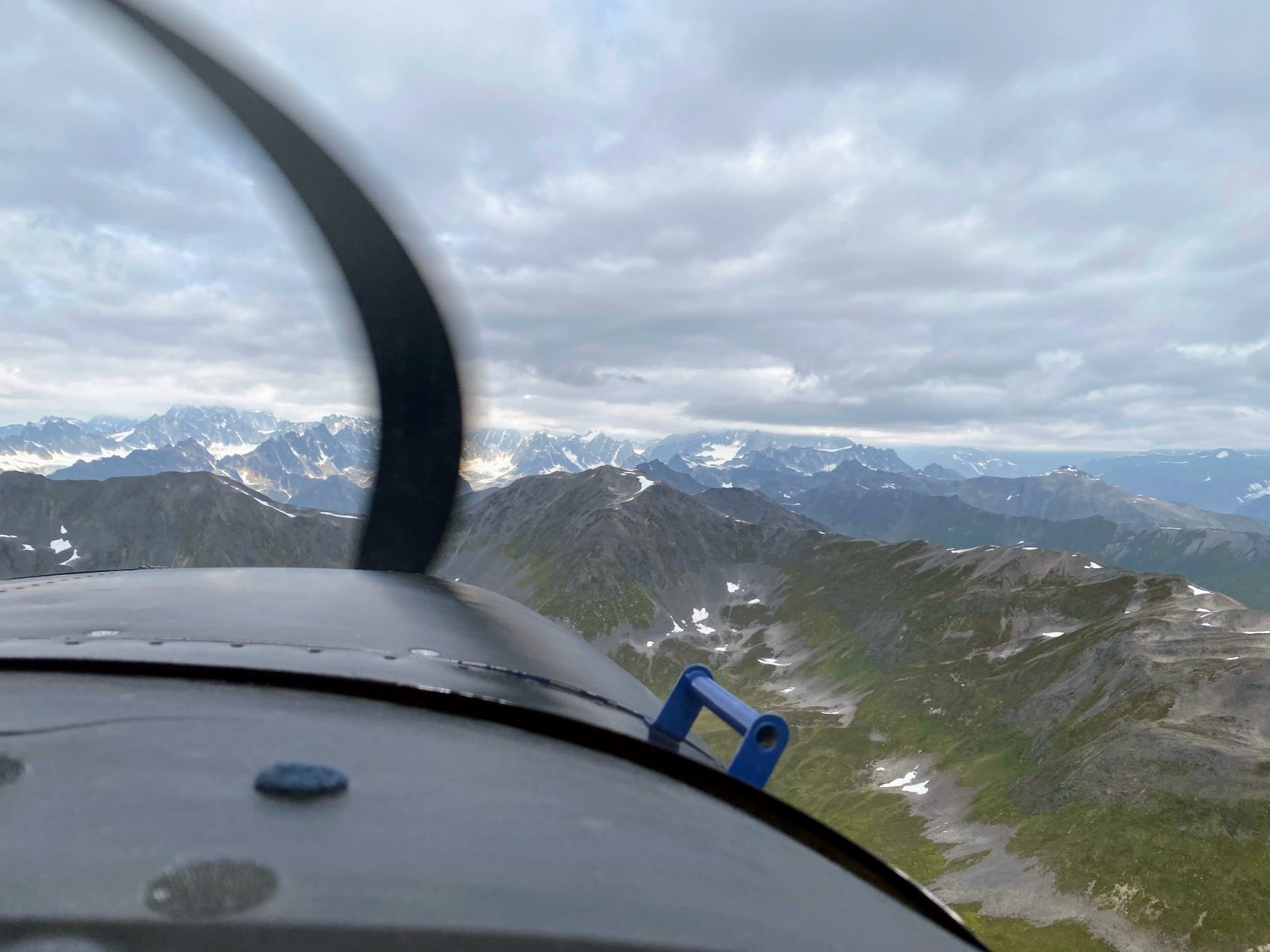
We darted through passes between steep, jagged spires of granite as we snaked our way through the lower elevation peaks in our agile ride. We swung sharply around a final pass, and the Pika Glacier was suddenly directly underneath us. Our pilot skillfully finessed the plane down onto the snow and coasted to the end of the runway, where we unloaded all of our gear and loaded it into the three sleds that we brought along for shuttling gear to base camp. We scouted base camp in a relatively safe compression zone on the glacier to minimize our risk of crevasses, but we still probed out a safe, rope-free perimeter for our camp to reside in for the next 4 days.
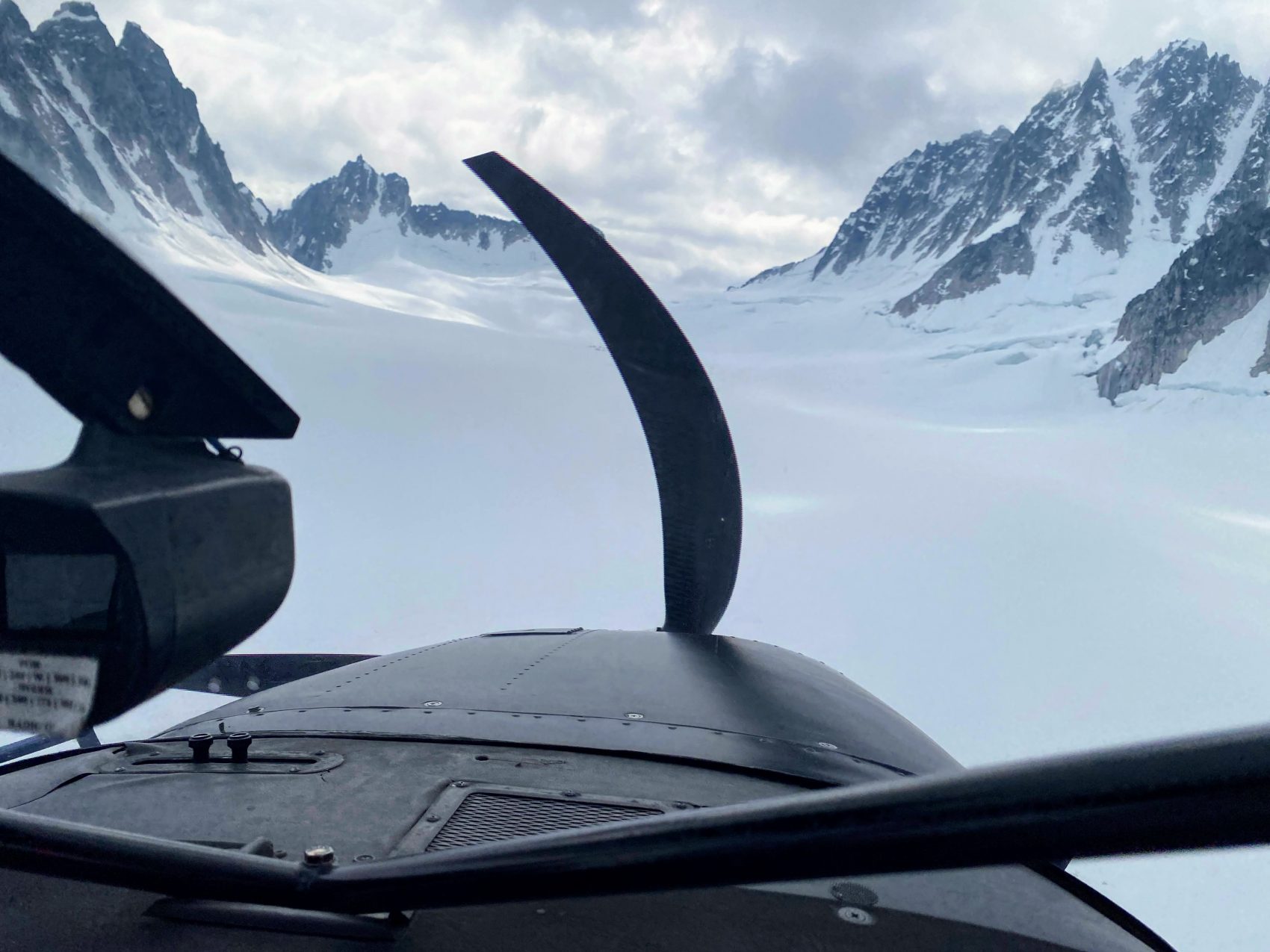
The pilot took off, leaving us to shuttle our gear to our campsite. There was one other group camped near us on the glacier, a mountaineering course through one of the 6 concessionaires that are permitted to commercially guide within Denali NP.
We quickly set up camp and melted some snow into water. Getting those chores done early gave us more time to ski that evening! Work before play.
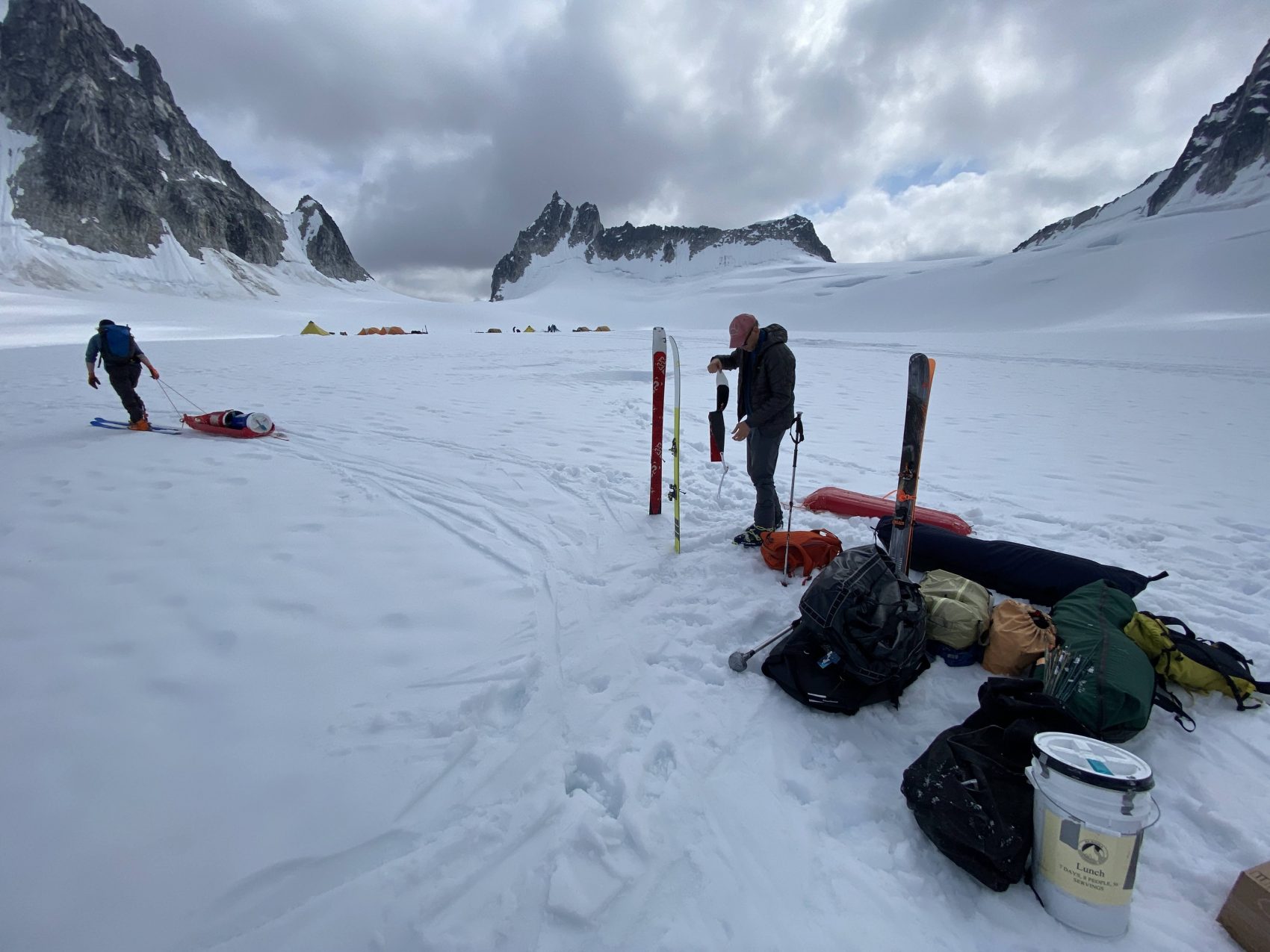
Once camp was set up, we started to rope up for an afternoon and evening of skiing. We did the usual – tied our harnesses, clipped our carabiners and equipment to our gear loops, tied our Prusiks onto the rope, and finally tied in. Once we were all roped up, we headed out.
Our objective was to bump up and over a pass to our south that connected to another glacier, the Crown glacier, to get some solid slush laps in before it got too late. At this time of year in Alaska, it really doesn’t get dark until 11-12 at night, so there was no real time constraint other than how much sleep we wanted to get that night!
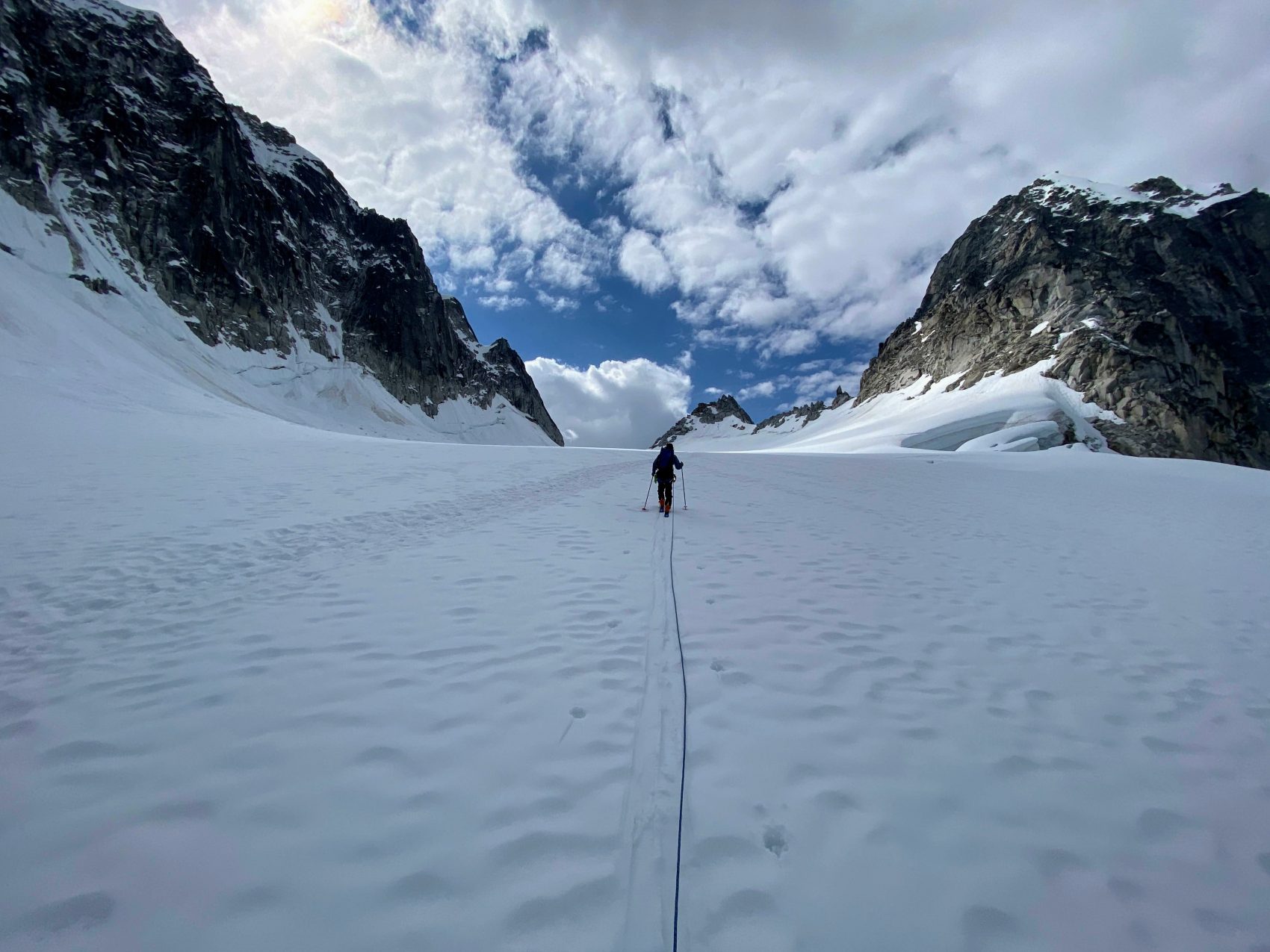
Once we were at the top of the pass, we laid eyes on our descent down the Crown Glacier. There were a few nice, mellow ramps that avoided significant convexities and crevasse risk. We felt comfortable unroping for the descent since we were confident that our line mitigated nearly all crevasse-fall risk.
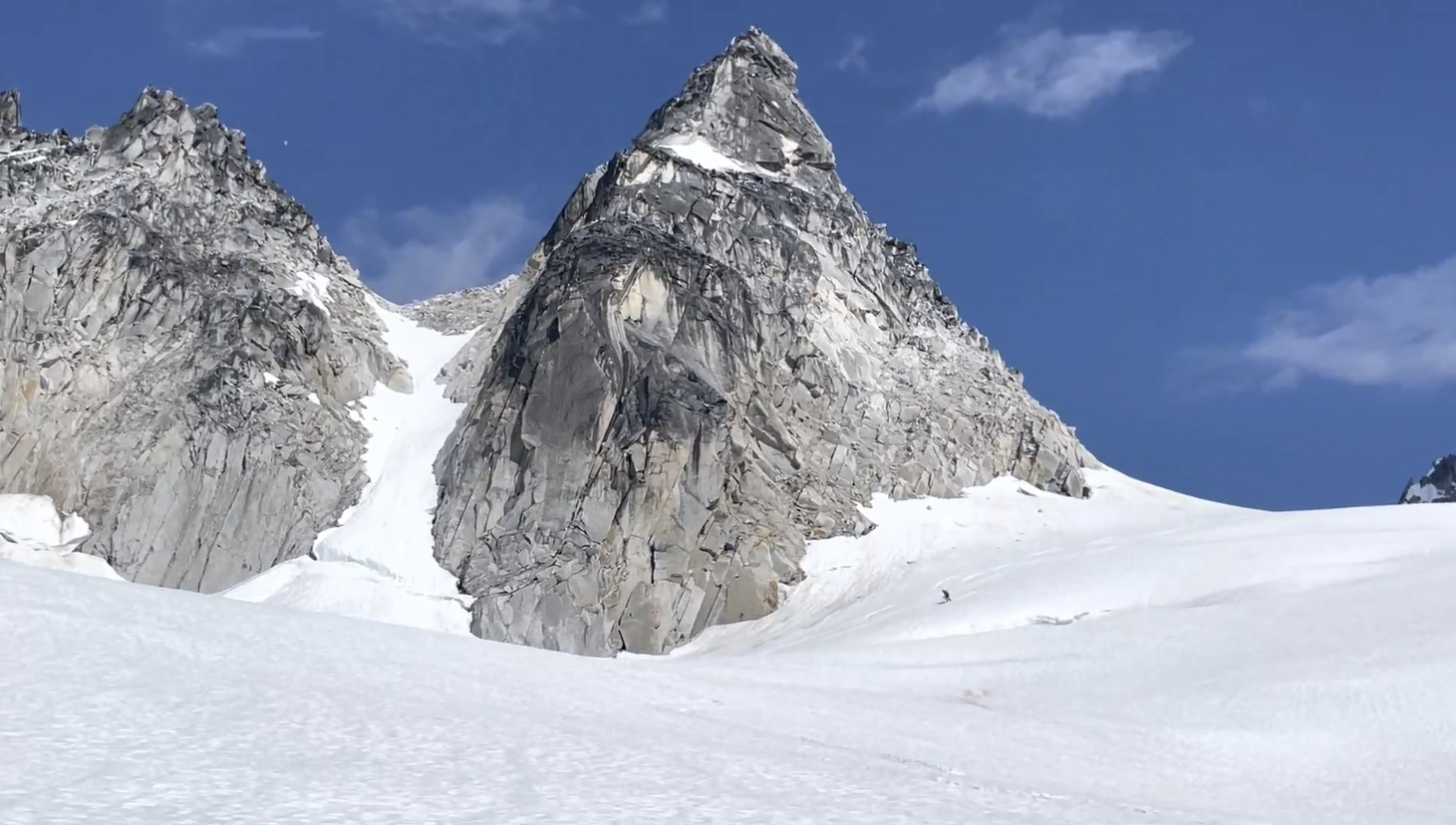
From the bottom of our first line, we saw tempting, steep series of pitches that meandered through the crevasses. We ascended our previous descent line and then worked our way onto some steeper pitches on the middle of the glacier.

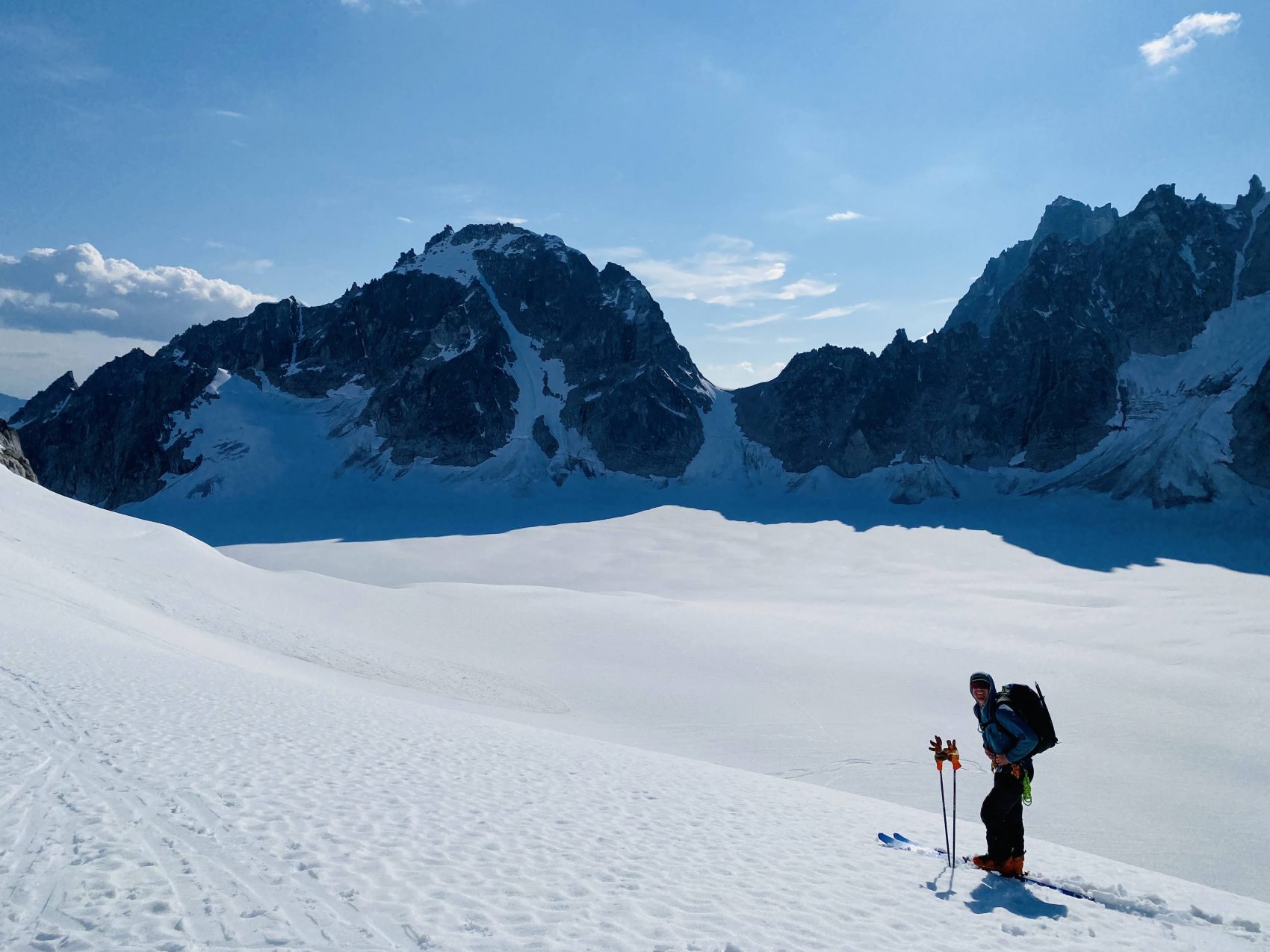
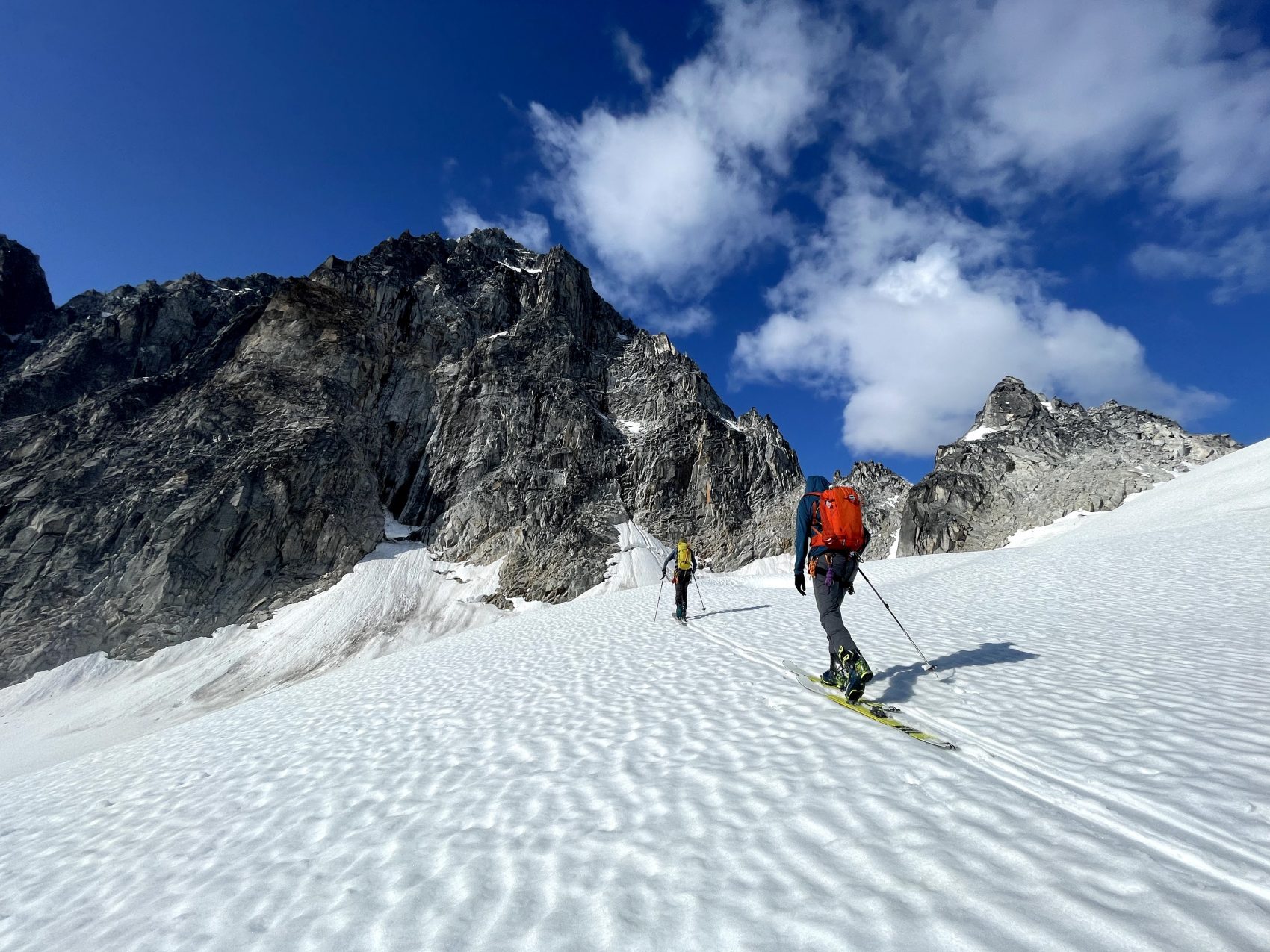
We feared that the snow would be suncupped, slow, and heavy. In reality, it was quite the opposite. The snow was buttery smooth and consistent and didn’t exert too much drag on the bases of your skis. It exceeded all expectations; it was almost perfect.
After a few laps, we toured back up and over the pass and descended down to camp. It was already 8:30pm, but the sun was still blazing out. The clouds around 17,402′ Mt. Foraker, Denali’s “Little Brother,” had cleared, giving us a stunning view of the mammoth massif as we linked slushy wiggles down to the Pika.
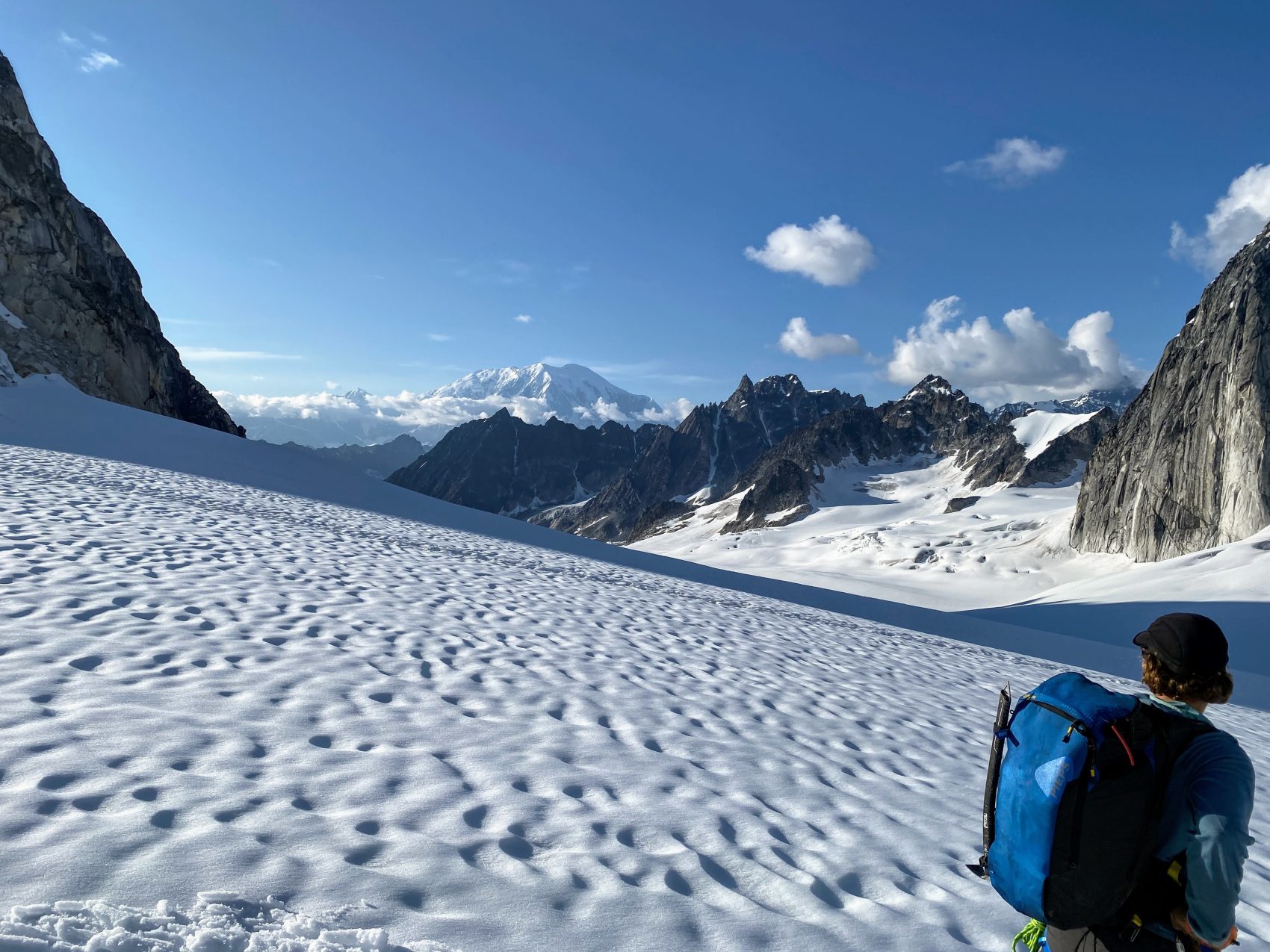
We got back to camp, cooked up some delicious pizzas for dinner as we enjoyed a spectacular, drawn-out Alaskan sunset, and then receded to the tent for the night.
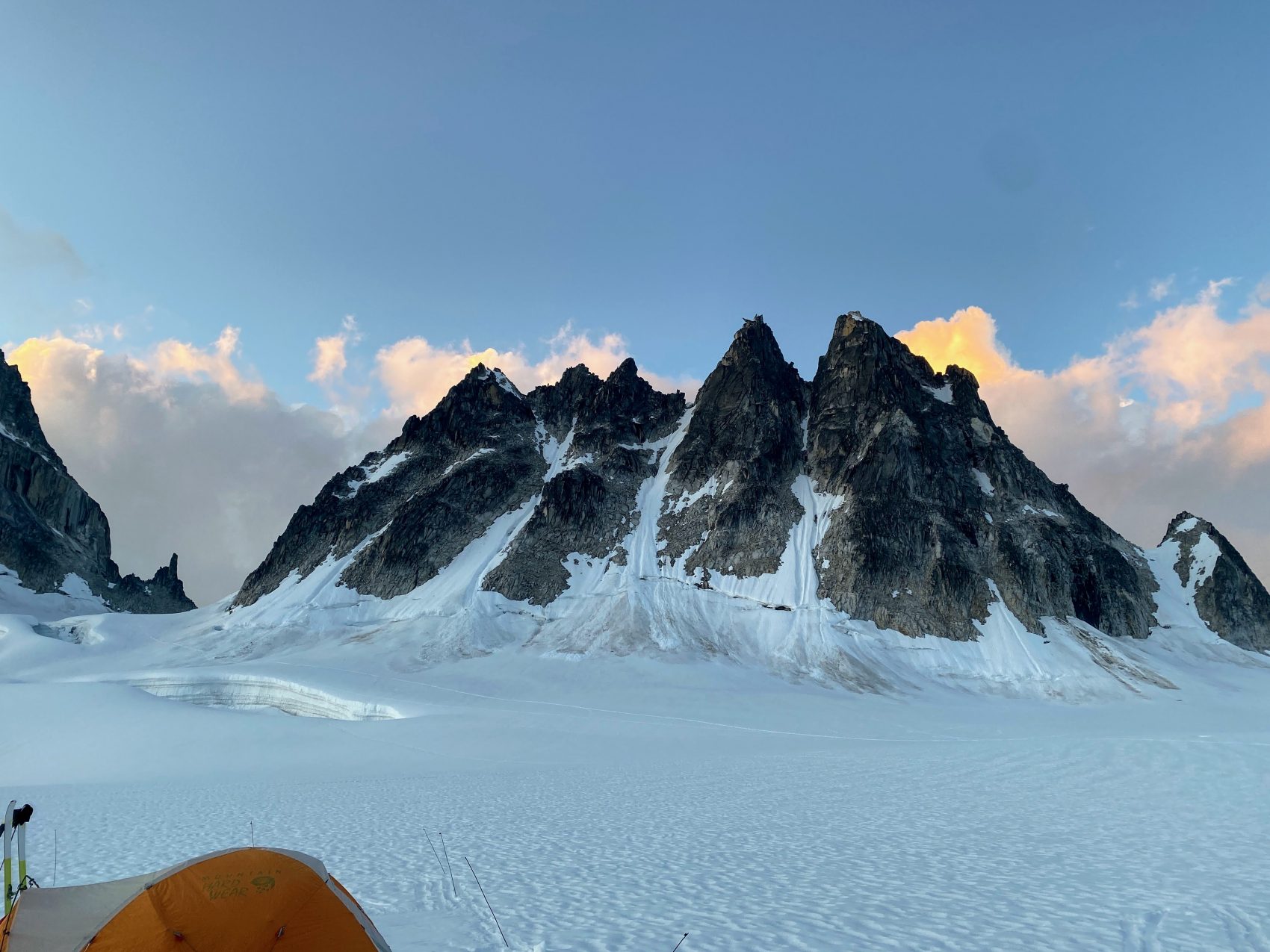
The next morning, we woke up to similarly spectacular conditions as the day before. Foraker greeted us from the tent door, and we got moving pretty early. We cooked up some oatmeal for breakfast, roped up, and headed out of camp.
Our goal for the day was to explore as much of the Crown Glacier as we could, so we worked our way up the previous day’s skintrack towards the Pika-Crown pass. At the top, we enjoyed buttery turns down the steeper pitches that we found yesterday. Rather than ascending back up the descent route towards the pass, we skate-skied our way across the entire width of the Crown to an enticing-looking descent that we had scouted on the 18th.
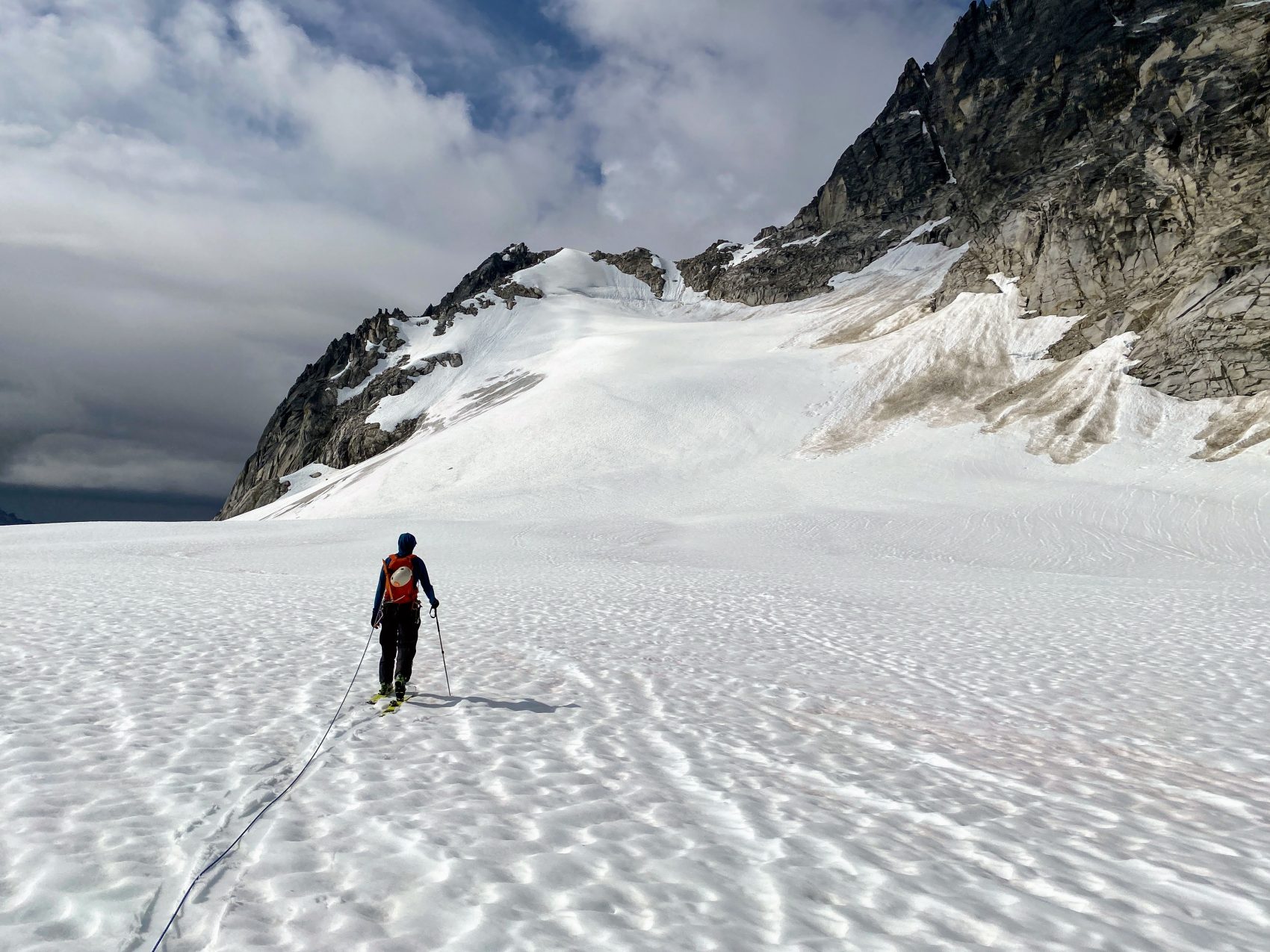
We roped back up and began ascending up the slope, all the way up to the bergschrund (a crack where the glacier pulls away from snow) at the top. On the way up, the sky had clouded over, and all of a sudden, it began to rain. Not too hard, but it rained enough to force us to don our rain jackets and waterproof layers. As we ascended, we were greeted by a spectacular show of fog that swirled through the granite spires and glacial valleys.
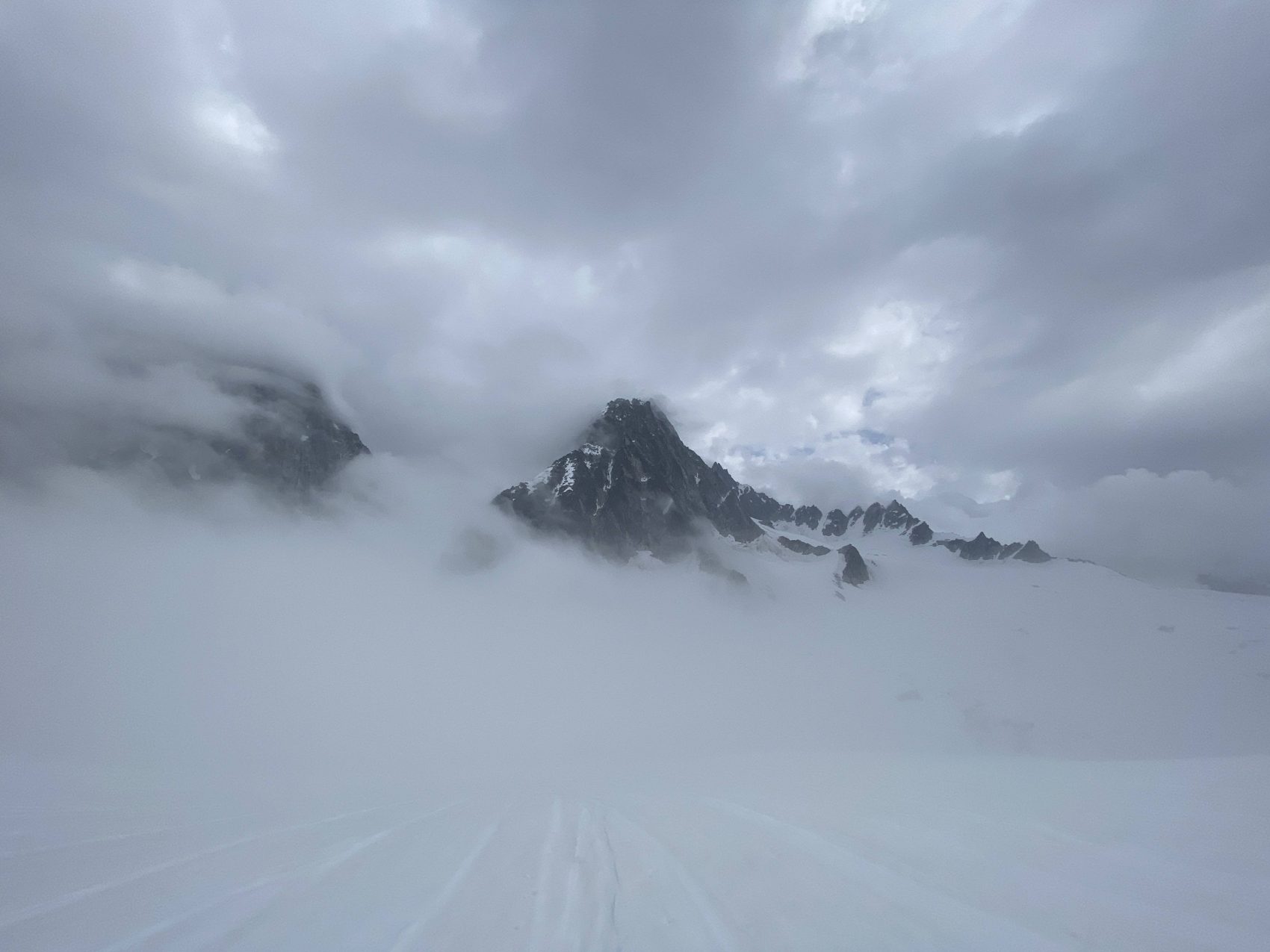
Since the snow was already wet, sloppy, and saturated, the rain made absolutely no difference on the texture. It still skied like consistent, over-ripe corn snow. It was still spectacular skiing for July.
At the bottom of our line, we popped back onto the flats of the Crown, where we once again donned our skins and roped up to continue exploring the glacier. We bumped up into an adjacent basin called Tribble Basin, which had a steeper snow slope that caught our attention. We worked our way up and around some tricky glacier ice up into. the basin, where we began ascending the slope. The snow, despite its ridiculously high moisture content, provided quite good purchase on skins, so we ascended the spit of snow on skins rather than boots.
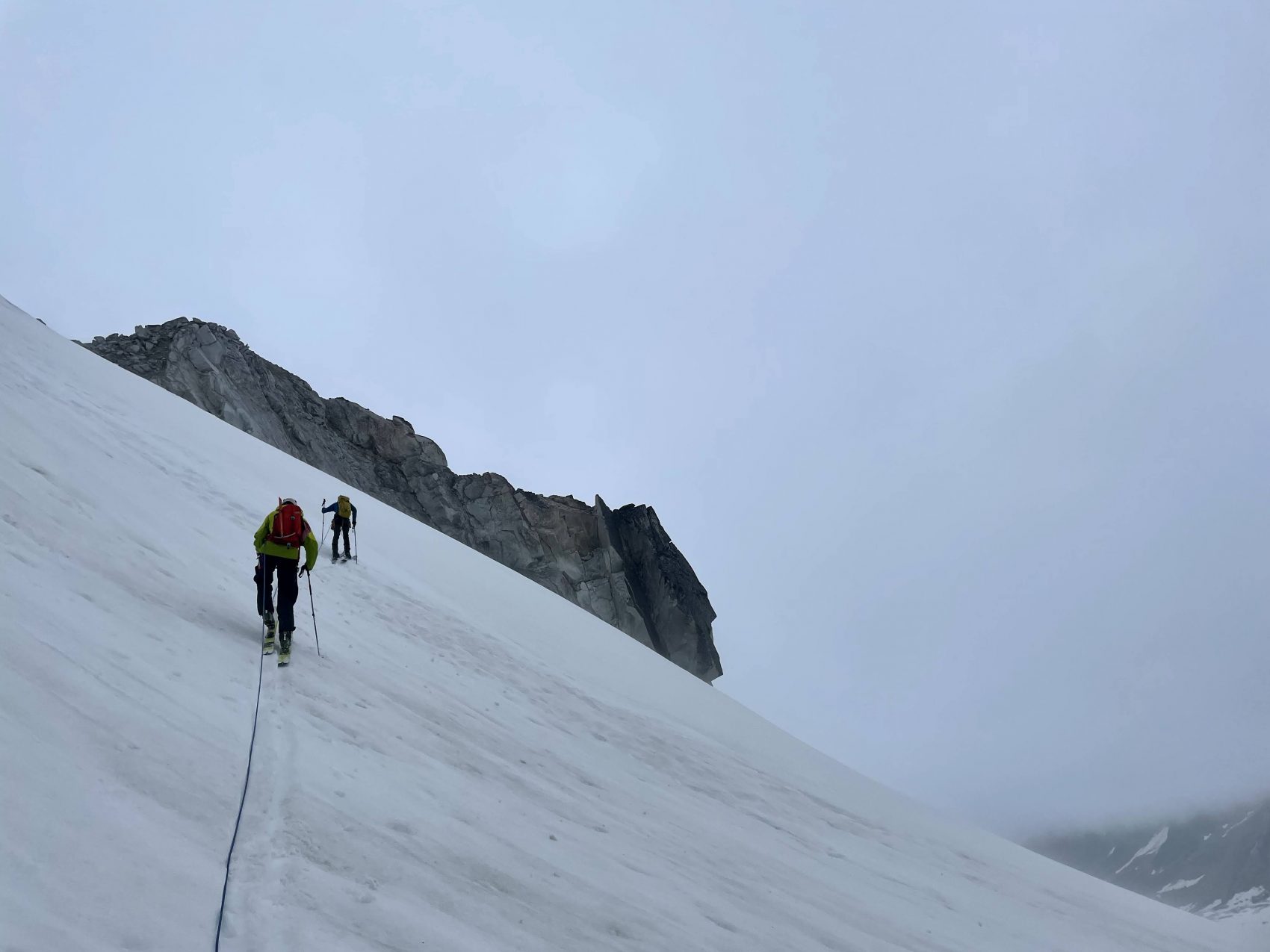
At the top, we found ourselves on top of a dramatic saddle with the next drainage to the east strewn out below us. The view, as we had become accustomed to, was amazing.
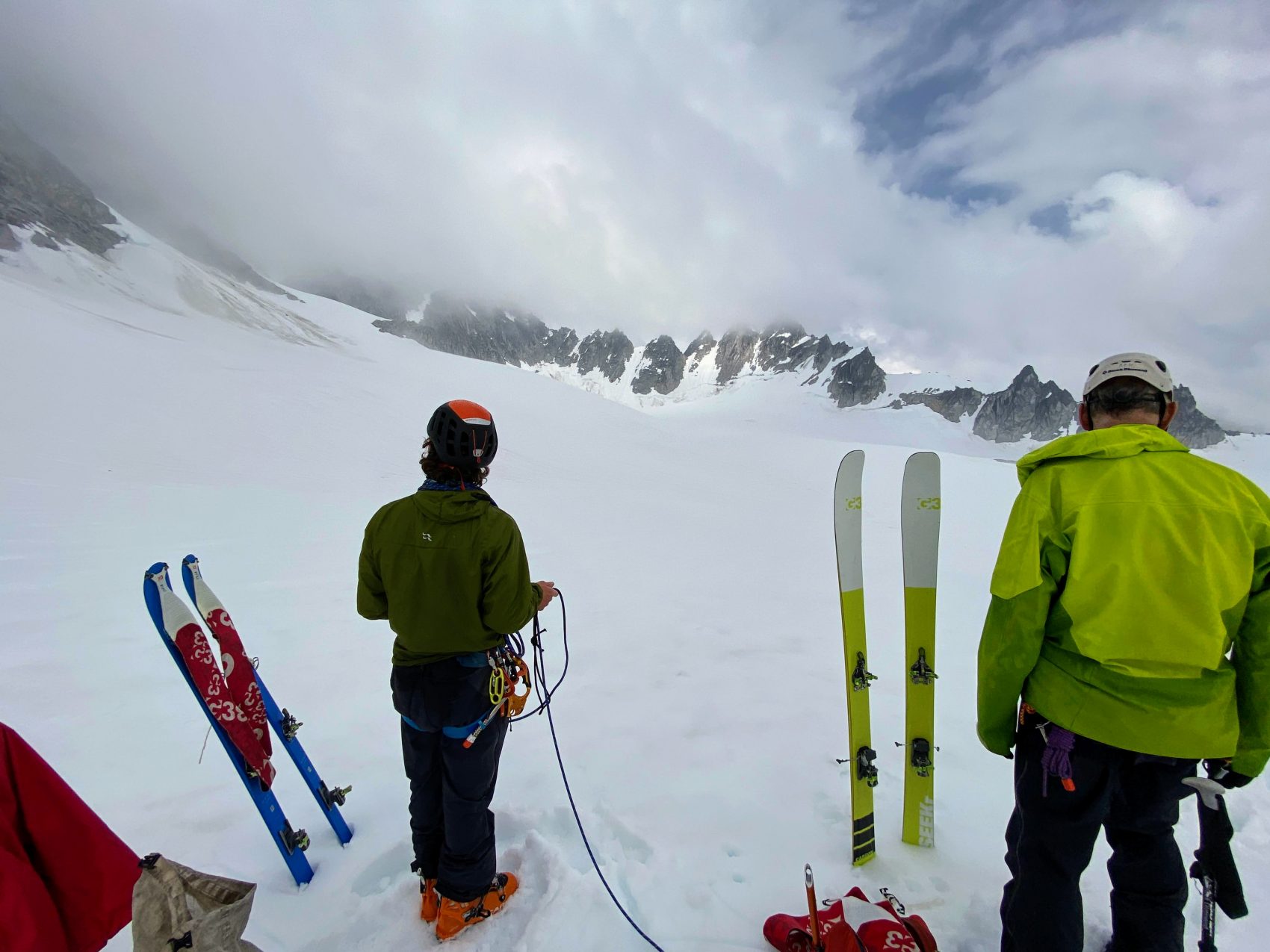
We decided to venture just a few minutes up the next drainage, just to get an extra pitch of skiing in.
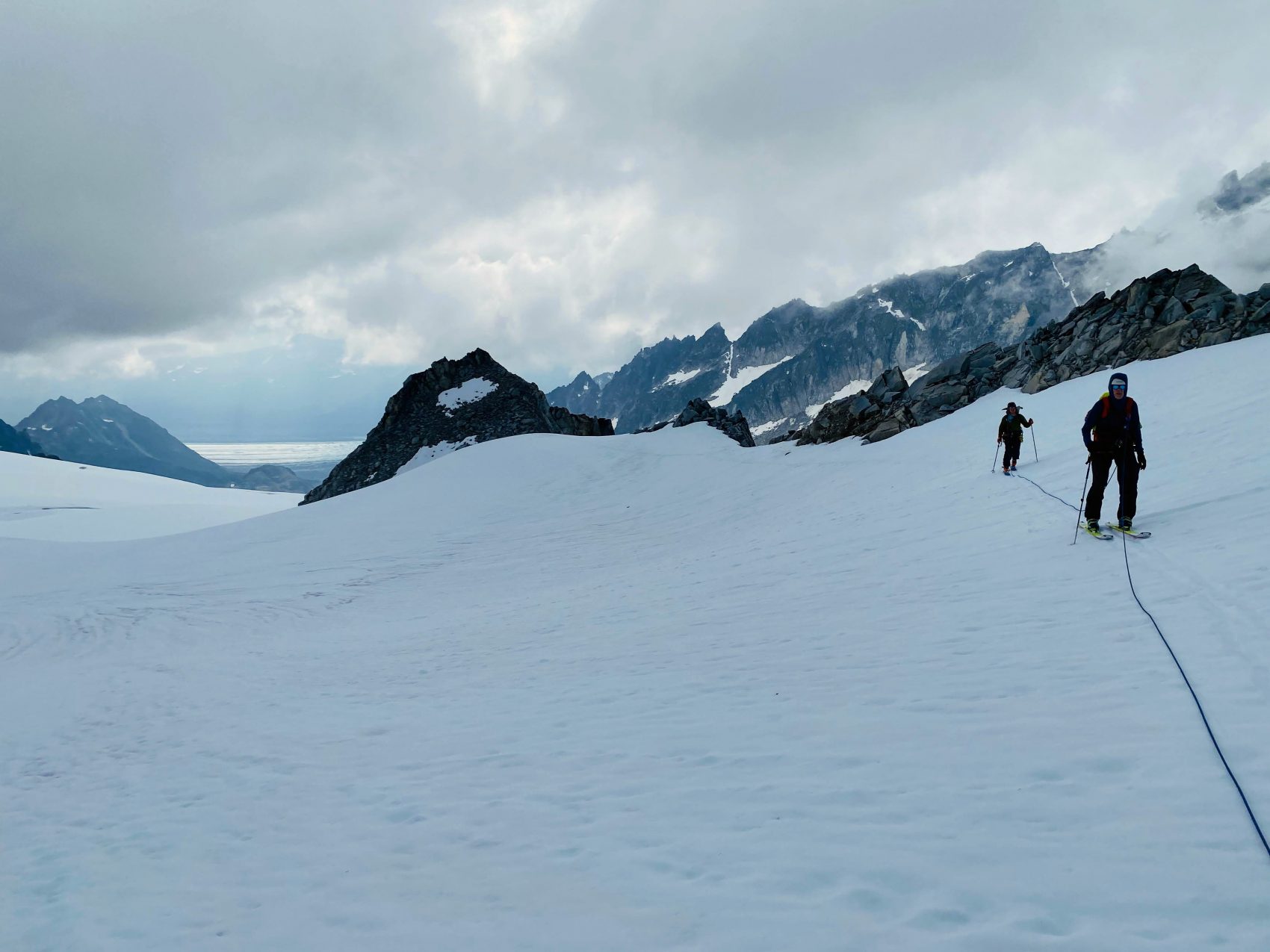
The turns down the pitches back to the Crown were exceptional. Perfect, consistent slush.
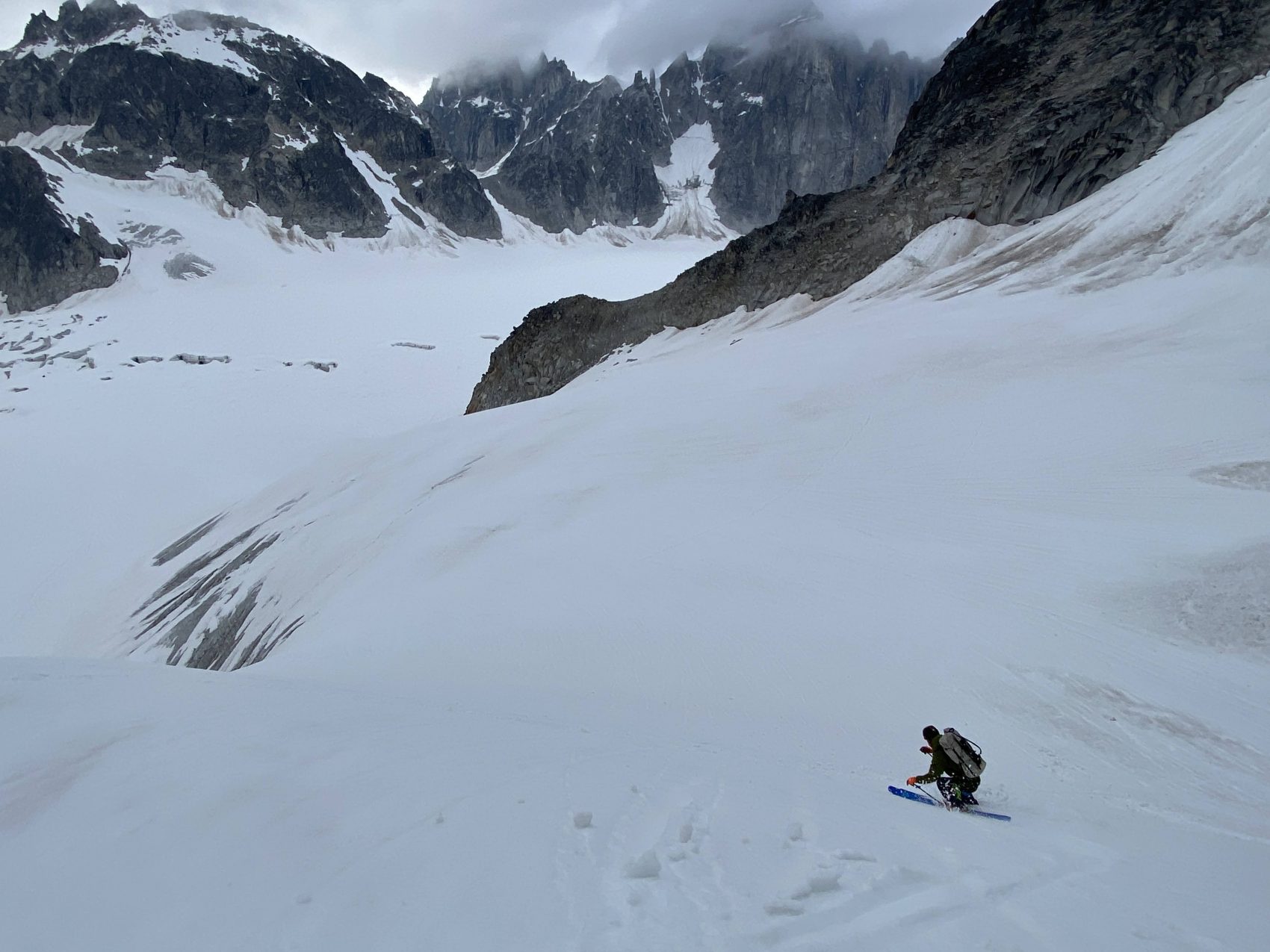
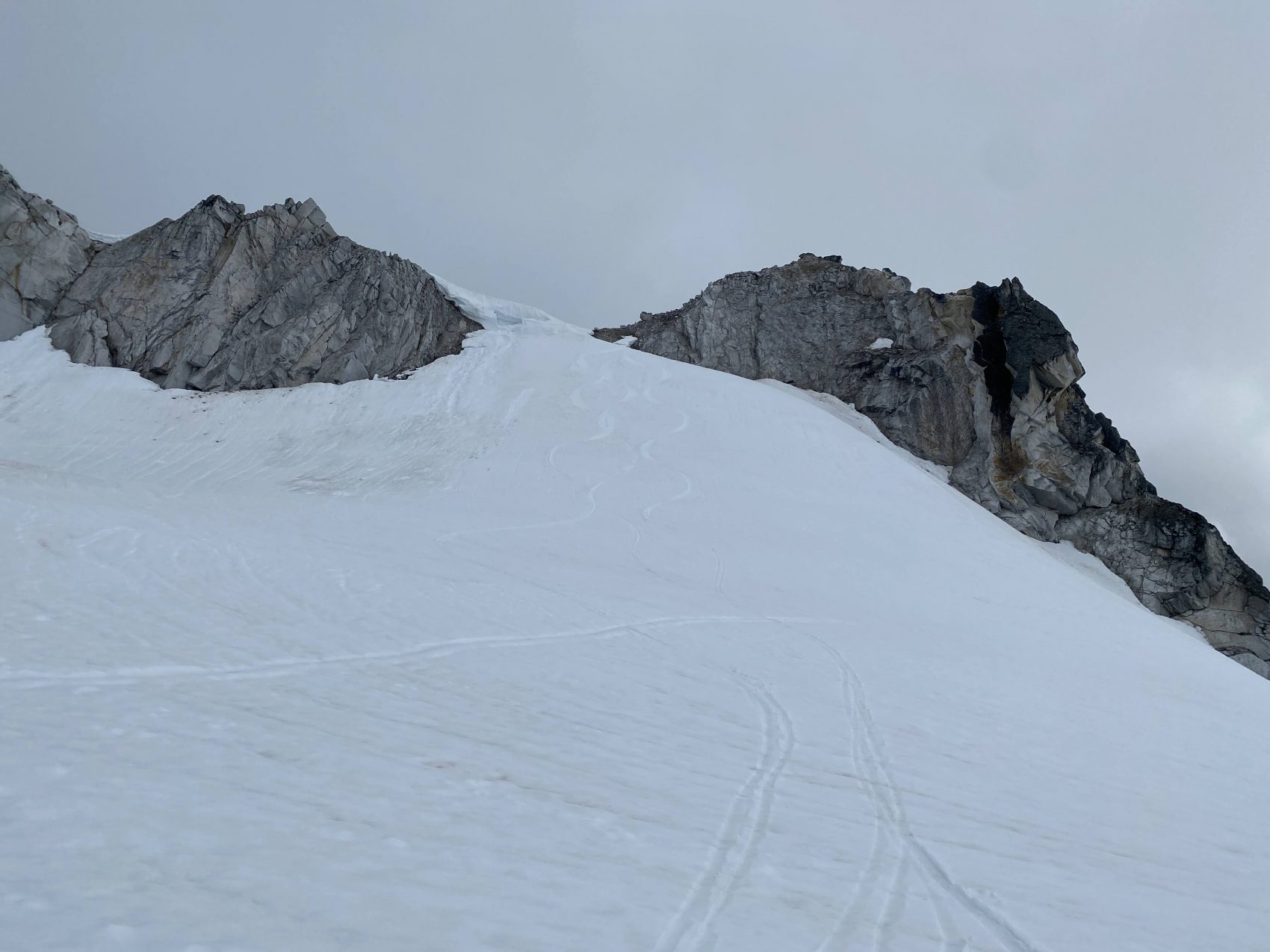

Once we got back onto the proper Crown glacier, the rest of our outing was spent traversing the glacier on skins and ropes and then ascending back up to the pass between the Pika and Crown. From there, exactly like we did last night, we skied two gentle pitches right back into camp.
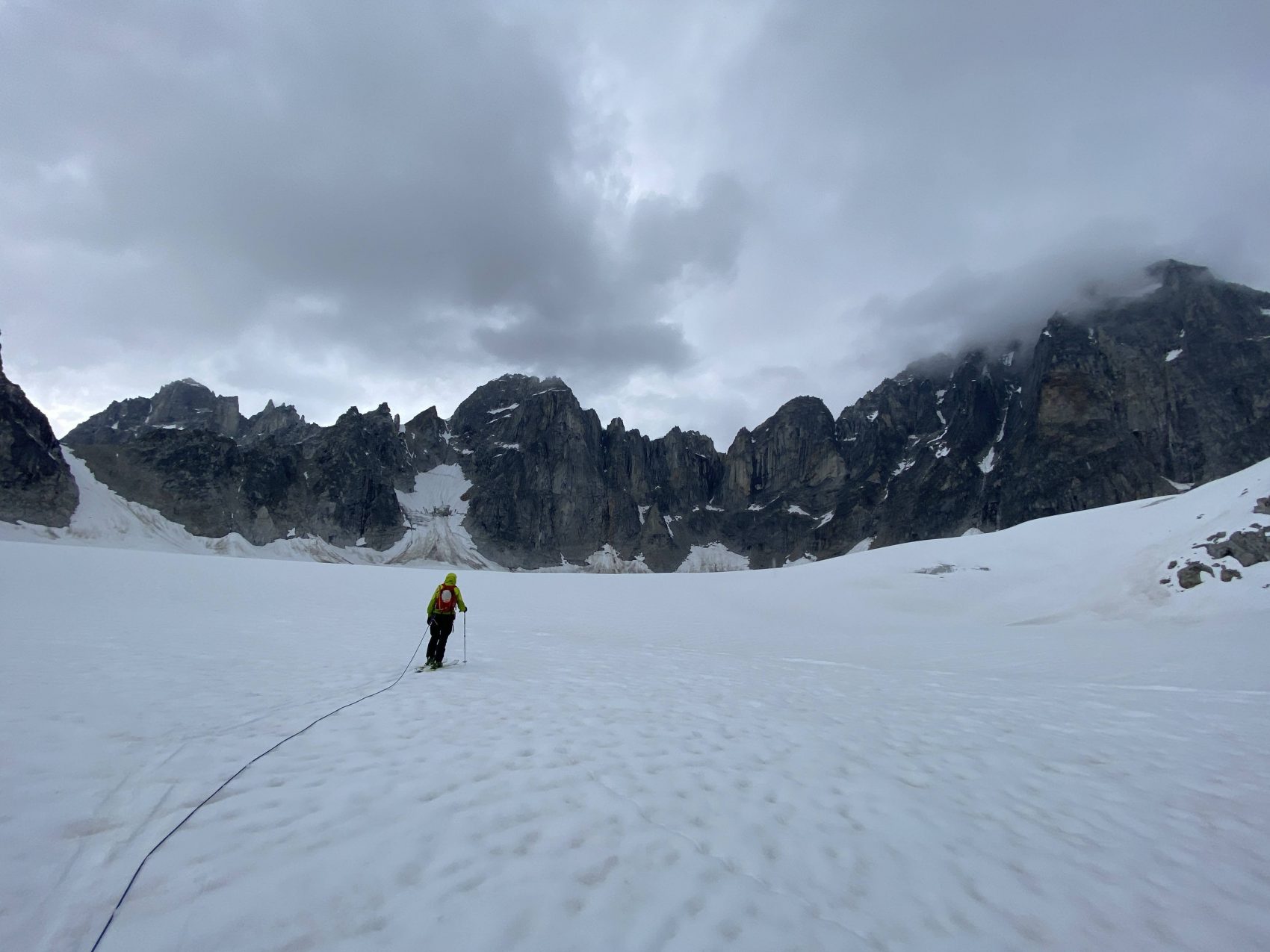
For dinner, we cooked salmon, quinoa, and rice, which was delicious. Since it was drizzling out, we spent the evening in the tent playing games, reading books, and eventually, falling asleep.
The next morning, the weather was absolutely perfect. There were a few thin, wispy, high clouds that were blocking at least a little bit of UV from the “Death Star,” but other than that there were no signs of precipitation! We were stoked and got out as soon as we could.
The objective for the day was to circumnavigate the 5 major upper Pika passes. We started by bumping up to a pass immediately to our east. The snow was a bit funky since there was a light freeze the night before. However, within minutes, the sun warmed it right up back into our beloved slush, and we enjoyed awesome turns down the west-facing headwall towards camp. It was so good, in fact, that we ended up doing another lap right then! After two laps, we had some very nice-looking tracks that we could see from camp perfectly!
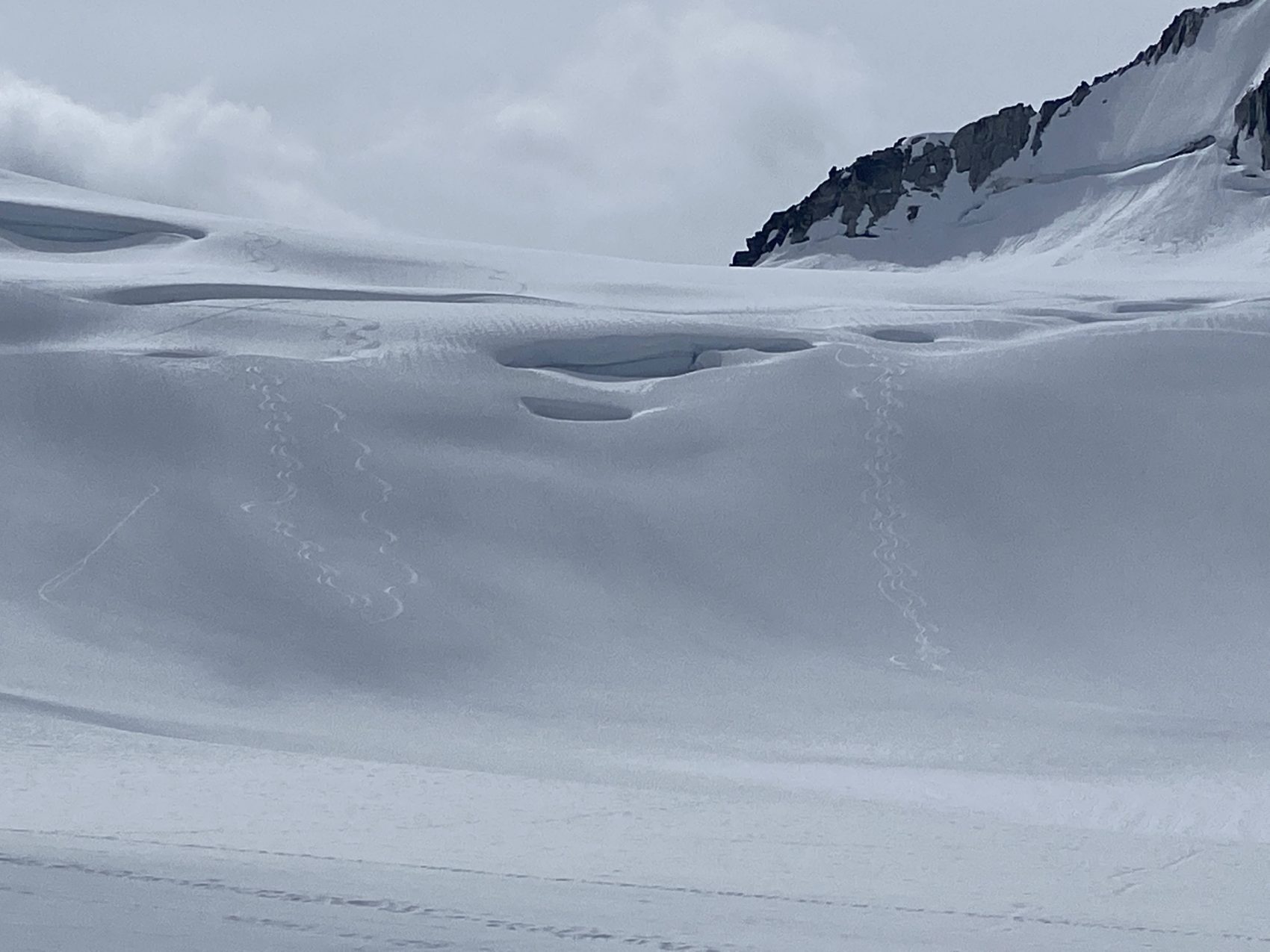
We continued around to the next pass, which was to our northeast (we were moving in a counter-clockwise direction). This pass was super mellow and had some awesome views down to the Granite Glacier a few thousand feet below. Once we had descended from that pass, we worked our way to our west around the Trolls. At this next pass, the clouds began to close in. Fog poured in from the northern side of the pass, and within minutes, we were in extremely dense fog and it began to rain.
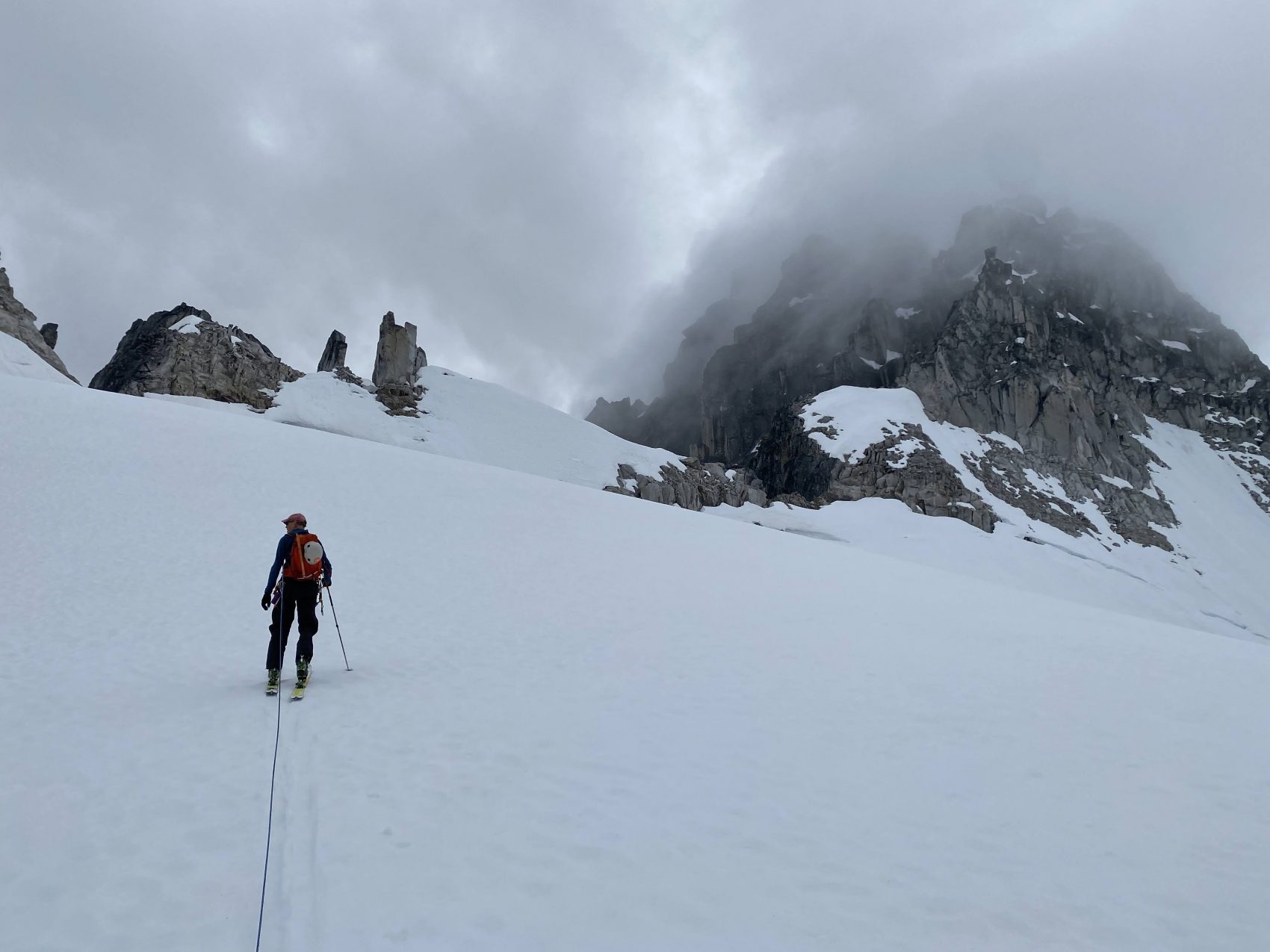
The view off the backside of the pass was breathtaking. Thousands of feet below laid the Granite Glacier, so far down that it was almost nauseating!
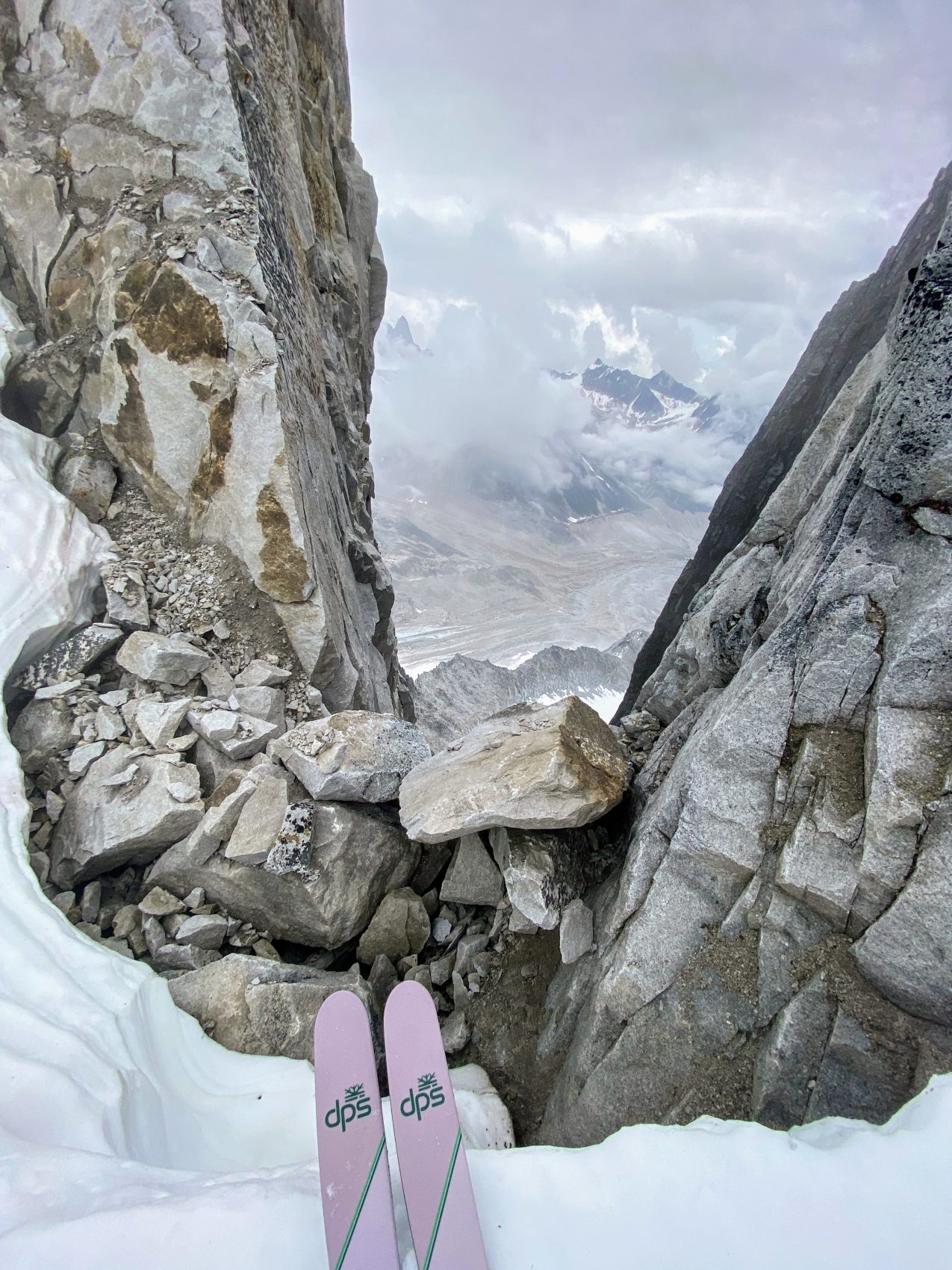
There was a steep snow slope above the glacier (about 55 degrees in pitch), and we decided to head up and ski it, despite the socked-in conditions. The snow was wet and sloppy but still provided firm enough climbing conditions as we crossed the bergschrunds and climbed up the slope. The descent was awesome; fun to get back on steeper terrain.
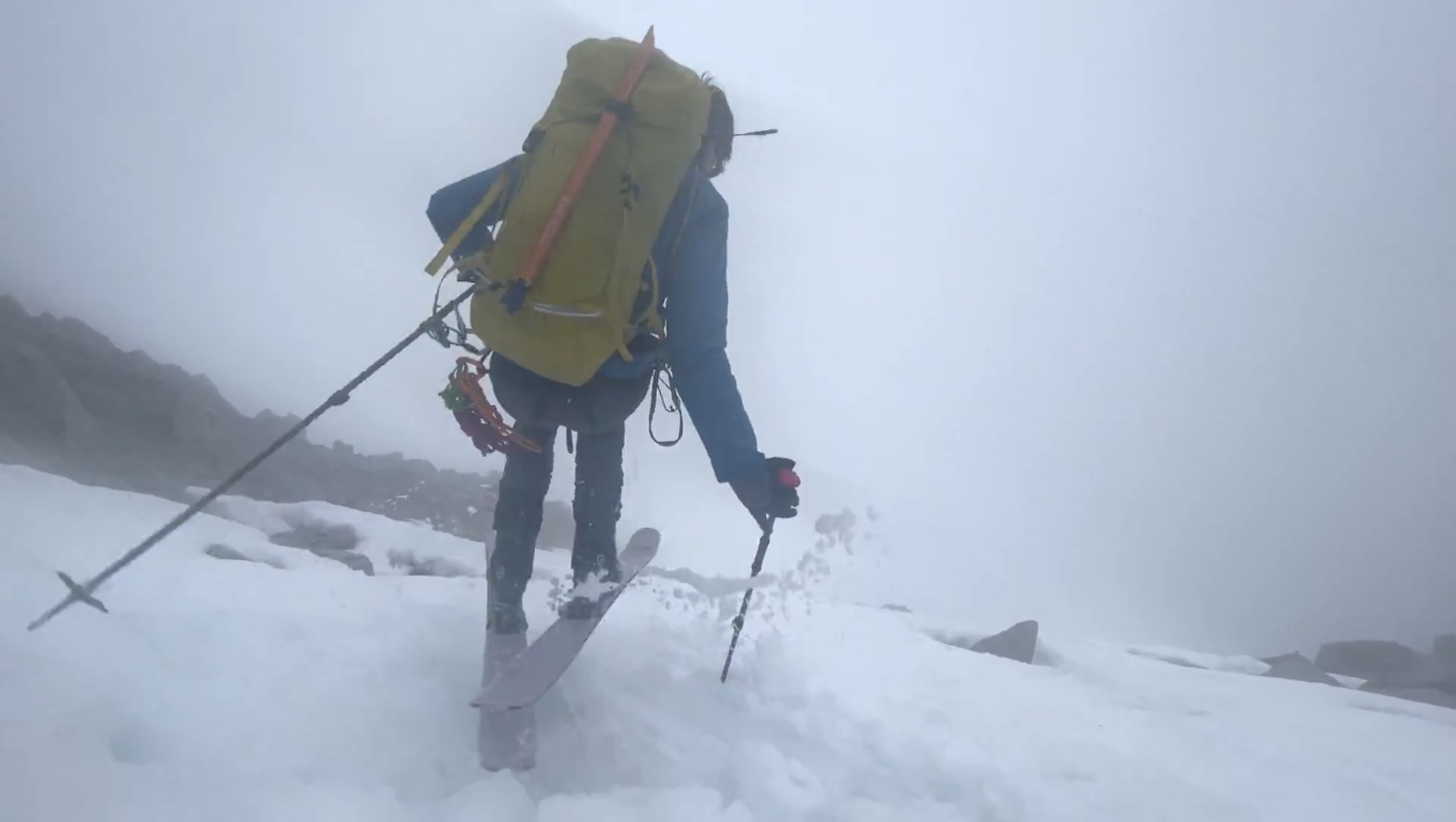
We skied down the large glacier ramps and worked our way around crevasses all the way back down to the Pika. By this point, it was raining really hard, but we’re not made of sugar!
The route to the next pass took us around a large granite spire known as the Throne around to a subsidiary glacier of the Pika. This glacier was riddled with cracks all over, so route finding was arduous, but eventually, we climbed the final steep pitch up to the pass. The view was… unspectacular, to say the least. On a clear day, the Granite Glacier would be visible a few thousand feet below with Denali looming in the background. But today, the fog was socked in and obscured our view of everything beyond about 150 feet away.
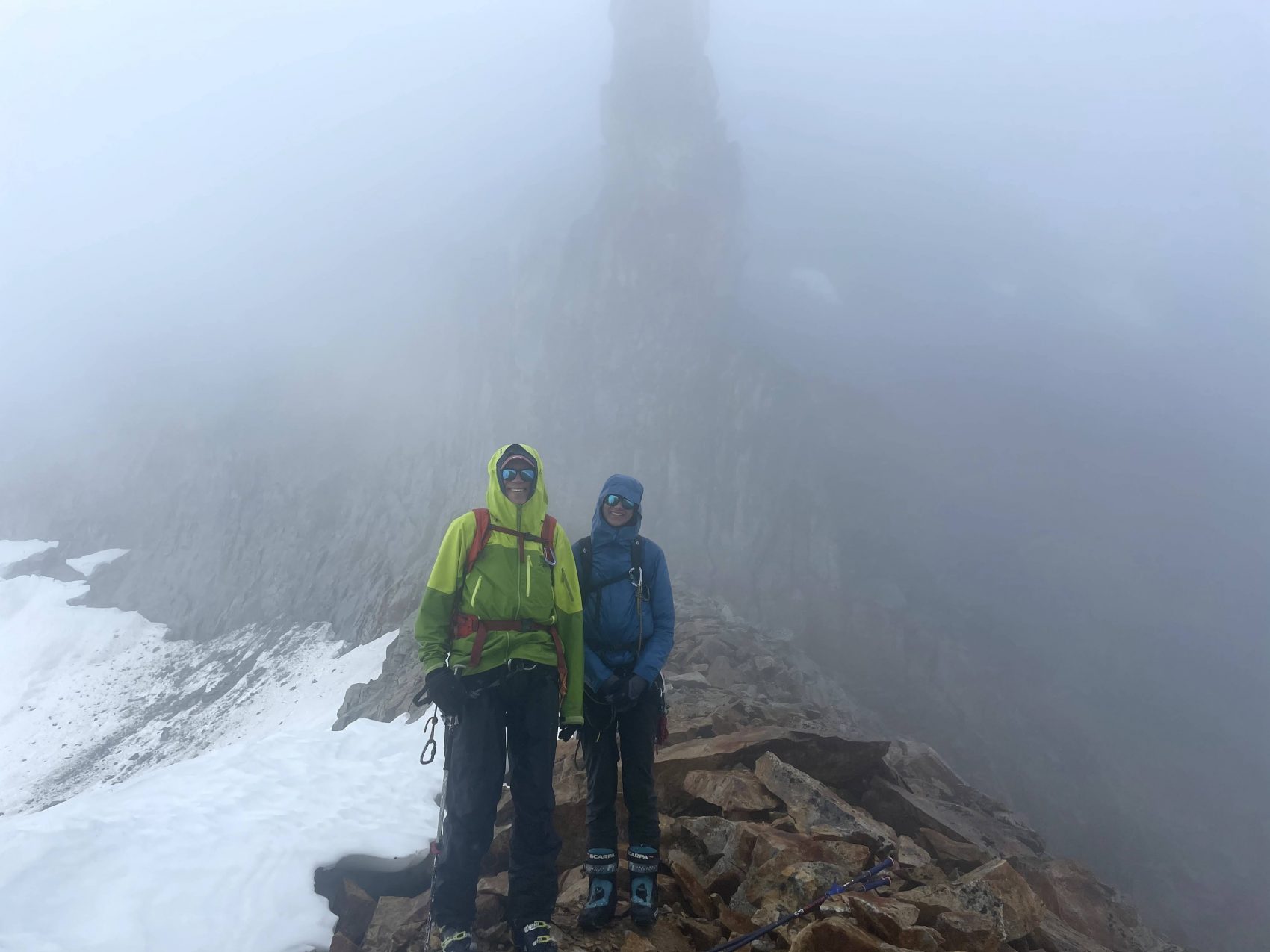
The descent from the pass was pretty mellow, with two or three steep pitches along the way. The snow hadn’t changed all day, since it was already so saturated, so we enjoyed more of the same slushy, consistent snow. Once back on the main Pika again, we put our skins back on and began working our way back towards camp on ropes. We took a quick 15-minute pit stop in camp to switch gloves, grab some more water, and put rain pants on. The rain was really coming down, but we wanted to complete our Pika traverse, so we braved the elements, clipped back in, and began touring back towards the Pika-Crown pass.
Near the top of this pass that we had now climbed over a few times now, there is a ridgeline that connects two small features known as Little Arapiles and the Munchkin. On the other side of this ridge laid another moderately sized deposition zone for the Pika, which we planned to ski. We could climb up that arm of the glacier, but we thought circumnavigating the Munchkin would be cool, so we ascended towards the Pika-Crown pass.
The ridgeline only rose about 100 vertical feet above the flat snow on the east side, near the Pika-Crown pass. However, accessing the top of the ridge is no small task. The slope is steep, about 60 degrees in pitch, which made us don our ice axes and crampons, just for extra security. Even more importantly, there was a large bergschrund, about 7 feet across, that blocked our access.
To navigate across the bergschrund, we spent about 20 minutes looking for a suitable snow bridge across the gap. We used Prusik belays to keep full tension on the rope, so if someone were to fall in the crack, there wouldn’t be any slack in the rope and we could arrest their fall quickly. Once we found a bridge, we tiptoed across one by one and then started up the slope to the ridge.
At the top of the ridge, we got a good look at our next descent. It was a snow-covered glacier with two steep headwalls, perfect for skiing. To access the true skiing, we had to do some quick hop turns down a steep, west-facing slope to navigate around some crevasses.
The skiing on our final line of the day was excellent, some of the best turns of the trip so far. The slope angle was perfect for nice, relaxed turns as we gracefully arced our way back down to the Pika one by one.
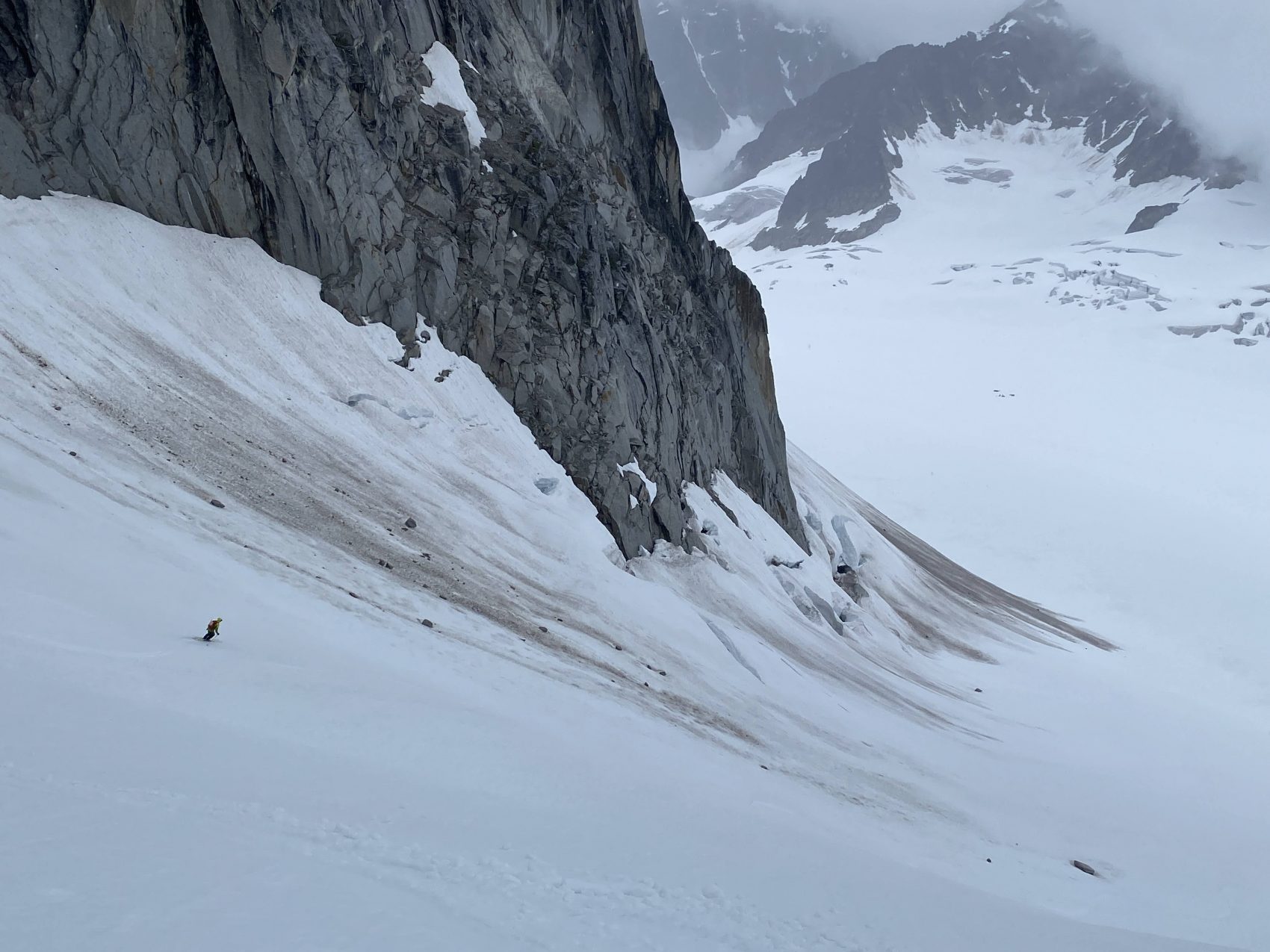

Once we were back on the proper Pika Glacier, we put on our skins, roped up, and made the short, 10-minute tour back to camp. At camp, we spent another evening in our tents due to the rain, desperately trying to dry our gear!
The next morning, things were not looking good for our scheduled afternoon pickup. It was raining and the whole valley was socked in; not good flying conditions. Regardless, we still wanted to go skiing, so we geared up and headed out.
Yesterday’s last run was so good that we wanted to just lap that all day! We toured over to the basin, established a nice skin track that would become our “highway” for the day, and started lapping.
We got some absolutely awesome laps in over the course of the day. In total, we did 6 laps of about 800 feet each, so we got plenty of great skiing in! We even got some “offseason” practice for our powder 8s (third clip in the video)!
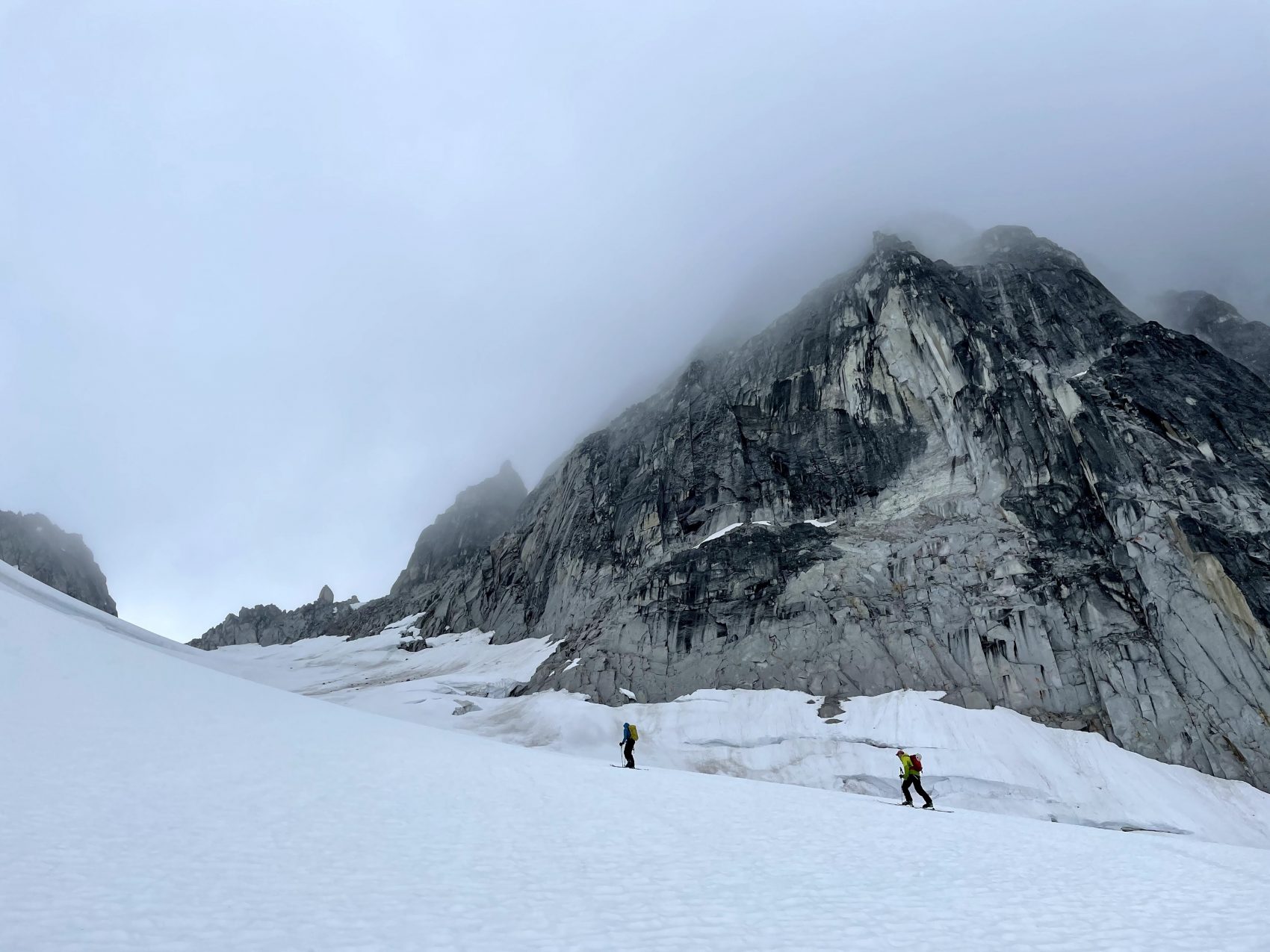

We headed back to camp in the early afternoon and used the rest of the day to sit in our tents, relax, and attempt to dry off our gear (with varied success). At about 7pm that evening, we called off our pickup for the day, as the weather showed no signs of improving.
The next morning, we woke up to a higher cloud ceiling and lighter rain. The weather was suitable for the pilots to land, so we got the go-ahead for a 9:30 am pickup. We quickly packed up our camp, shuttled it to the airstrip, and then went for one quick final run. We arrived back to camp from our skiing right as the plane landed, and we unclipped from our bindings, loaded up our gear, and flew back to Talkeetna.
Overall, it was an amazing trip! We got some great slushy turns, really good considering the time of year! Additionally, we checked off our 26th consecutive month of skiing, which felt great!